Kete Kōrero
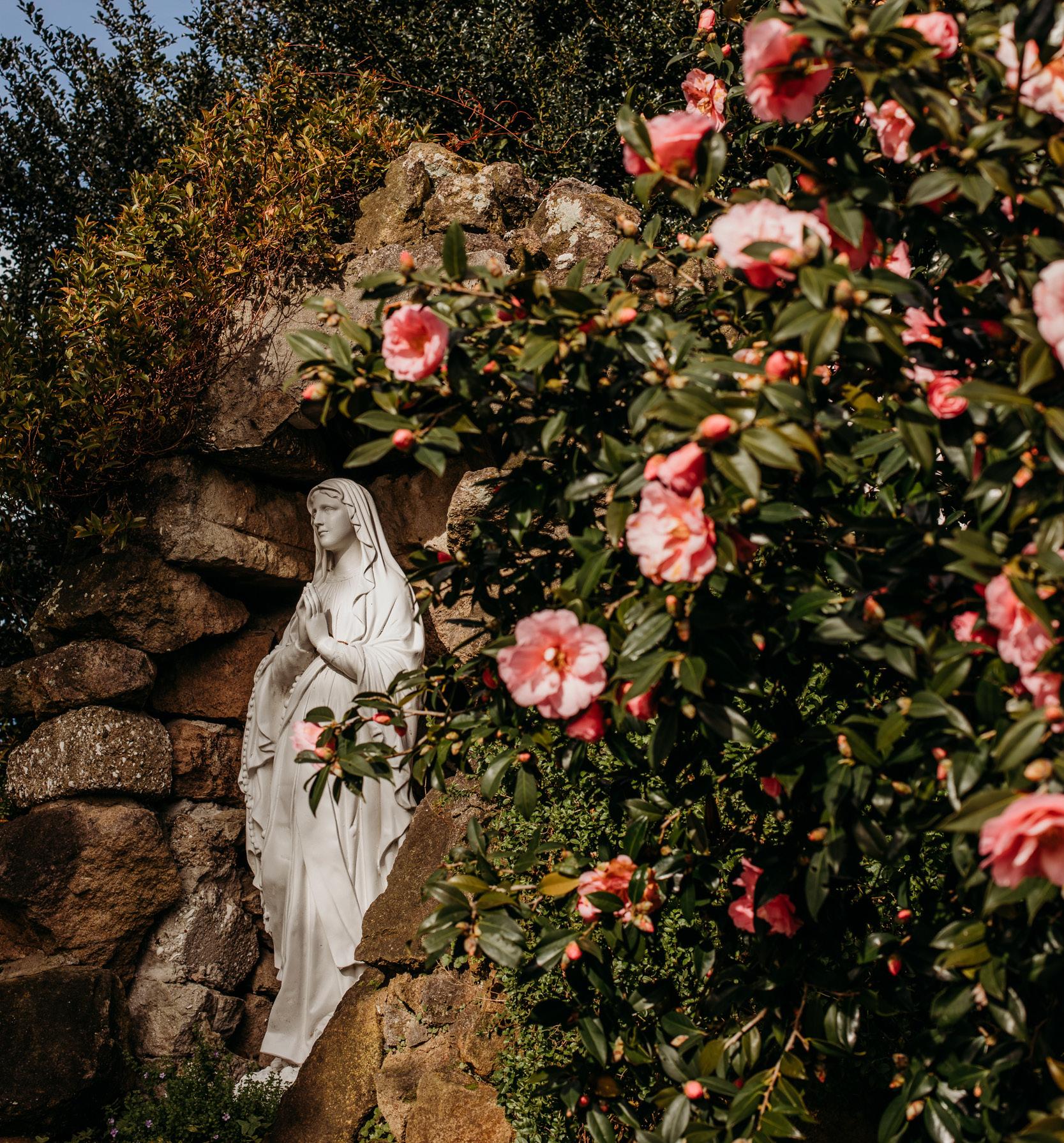
A MAGAZINE OF THE CATHOLIC DIOCESE OF HAMILTON SEPTEMBER 2023
SEPTEMBER 2023
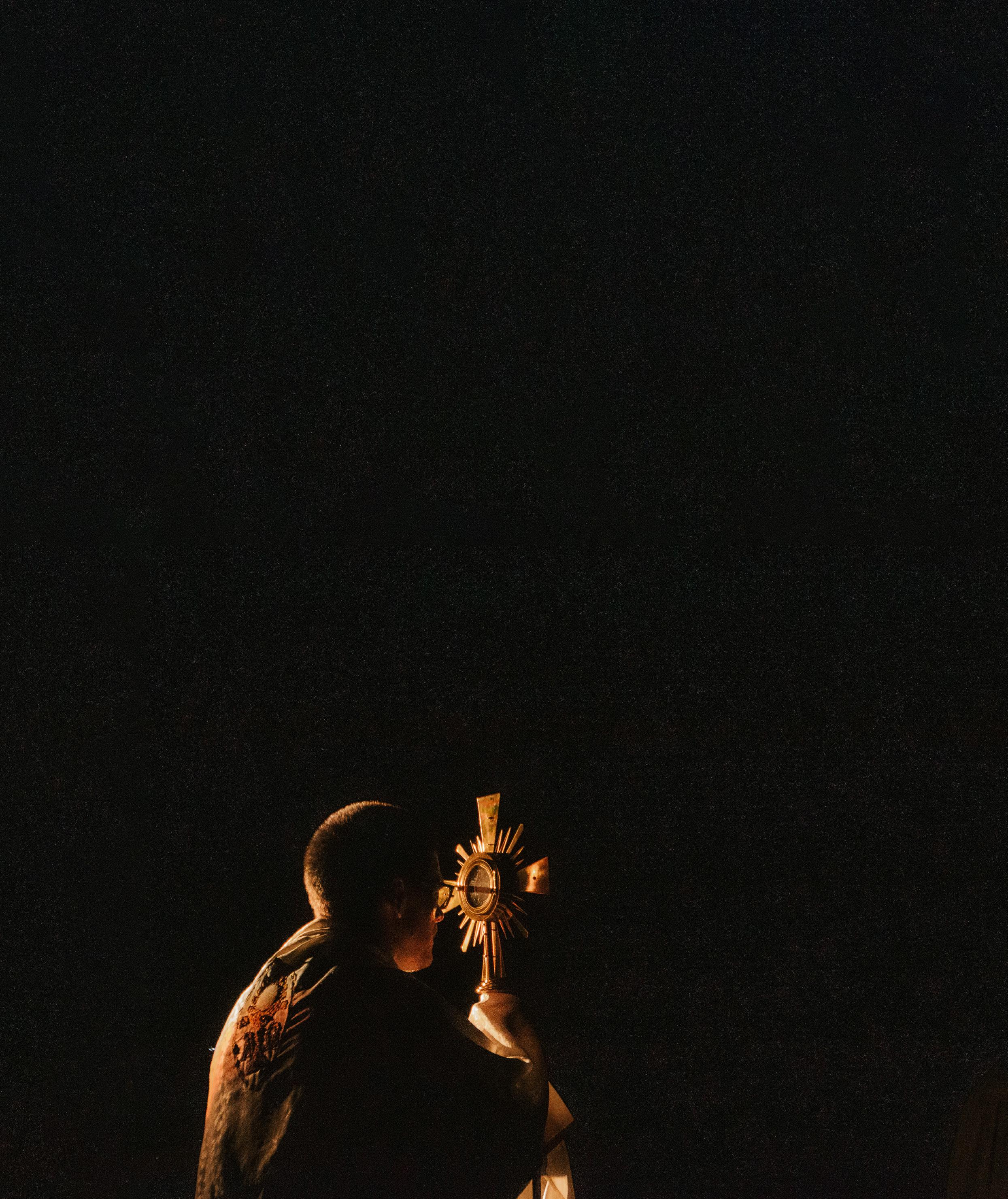
PUBLISHER: Catholic Diocese of Hamilton, New Zealand EDITOR: Samuel Harris samuelh@cdh.org.nz

ASSISTANT EDITOR: Kirsty Muir ART DIRECTOR: Taila Burton-Gollop
MANAGING EDITOR: Alex Bailey
PROOFREADING ASSISTANCE: Shona Roberts
ketekorero.cdh.nz
kete@cdh.org.nz
CONTENTS THE SPIRITUAL LIFE: CHRIST SEES YOUR HEART / JUANITA RAMAN 06 LIGHTING FIRES AT AQUINAS / SUSAN VAN ZYL 10 FROM VIETNAM TO THE WAIKATO / KIRSTY MUIR 12 MARRIAGE AND FAMILY: PAEROA FAMILY GROUP / KIRSTY MUIR 15 CALLED TO SERVE: THRIVING LIVES / BEN SOKIMI 16 THANK YOU / BETTY-ANN KAMP 18 NEWS AND EVENTS: FAITH MEETS HISTORY / KIRSTY MUIR 04 COMPETITION AND CONNECTION / LEON ROBERSON 20 CATHOLIC WOMEN’S LEAGUE / CLARE GALLAGHER 20 KAKE ORANGA HĀHI KATORIKA / TAILA BURTON-GOLLOP 21 WHĀNGAIHIA TE NGĀKAU – RONGOHIA TE WAIRUA / EMALENE CULL 22 OUR SACRED PLACES: FROM FONT TO BIRDBATH AND BACK AGAIN / FATHER GERARD BOYCE 24 ART AND CULTURE: THE SHOCK OF SPRING: BOOK REVIEW / RICHARD TURNBULL 27 IF I AM ONLY FOR MYSELF: THEATRE REVIEW / SAMUEL HARRIS 28 TITLE: MUSIC REVIEW / SAMUEL HARRIS 30 QUIZ 03 LETTER TO THE EDITOR 26 SPRING 2258 26 SAINTS & SOLEMNITIES 30 KIDS’ PAGE 31 CATHOLIC ANSWERS CY KELLETT TOUR 31
WEBSITE:
EMAIL:
PHONE: 07 856 6989 POSTAL ADDRESS: PO Box 4353 Hamilton East 3247 ISSN 2357-2221 COVER: CLUNY RETREAT CENTRE, TAURANGA CONTENT PAGE & BACK COVER: SET FREE 2023 02
EDITOR’S NOTE
SAMUEL HARRIS
“Be not afraid,” Pope Francis reminded pilgrims at World Youth Day in Portugal last month, reminding them of the words of Jesus to his terrified disciples: “Take heart, it is I; do not be afraid.” Juanita Raman’s article in this spring issue of Kete Kōrero gets across the joy and enthusiasm of the Kiwi pilgrims as they journeyed to Lisbon and gathered there with other young people from around the world for celebration, catechesis, and laughter. Back home, other groups or individuals from our diocese have made other journeys - to Maketū, to Palmerston North, to Auckland, to Waikato from Vietnam - and Susan van Zyl, Kirsty Muir, and Emalene Cull tell those stories. Fr Gerard Boyce describes another journey - a marble font from one of our churches travelled from Melville to Whakatane and back again, restored and renewed, to a place in the St Pius X sanctuary.
“Society needs artists,” said Pope St John Paul II, and this magazine agrees and aims to publish reflections or reviews of different pieces of art - in this issue, poetry, theatre, and contemporary music - that might help illuminate aspects of the good, the beautiful, and the true.
As always, we’d like to thank those who give up their time to contribute to these pages. We really appreciate this and couldn’t put the magazine together without you. If you have a story to tell or please get in touch and we’ll see if we can assist in putting it together to share with the diocese. We hope to feature in December’s issue several pages featuring brief snippets of “highlights from the year” from schools, parishes, chaplaincies, orders, groups, and charities around the diocese, so if you have something you’d like to see in those pages, let us know.

QUIZ
QUESTIONS COMPILED BY LIFE TEEN HAMILTON
1. What are the names of two hats sometimes worn by clergy?
2. Who is currently the youngest priest in our diocese?
3. In what year was the Cathedral of the Blessed Virgin Mary first opened?
4. How many books are in the Bible?
5. Whose name did God change to Israel?
6. In what language was the 1992 Catechism of the Catholic Church first published?
Answers on page 09
03
FAITH MEETS HISTORY
BY KIRSTY MUIR
A day spent immersed in the richness of our oldest church.
The Church bells rang out through the small town of Maketū on a radiant sunny Thursday morning in July. Fifteen members of the Catholic Women’s League (CWL), Mount Maunganui chapter, were welcomed into St Peter’s Catholic Church by Deacon Douglas Rewi. This pilgrimage, organised by Margaret Sherry, was made with the main aim of learning about the history of the oldest church in our diocese.
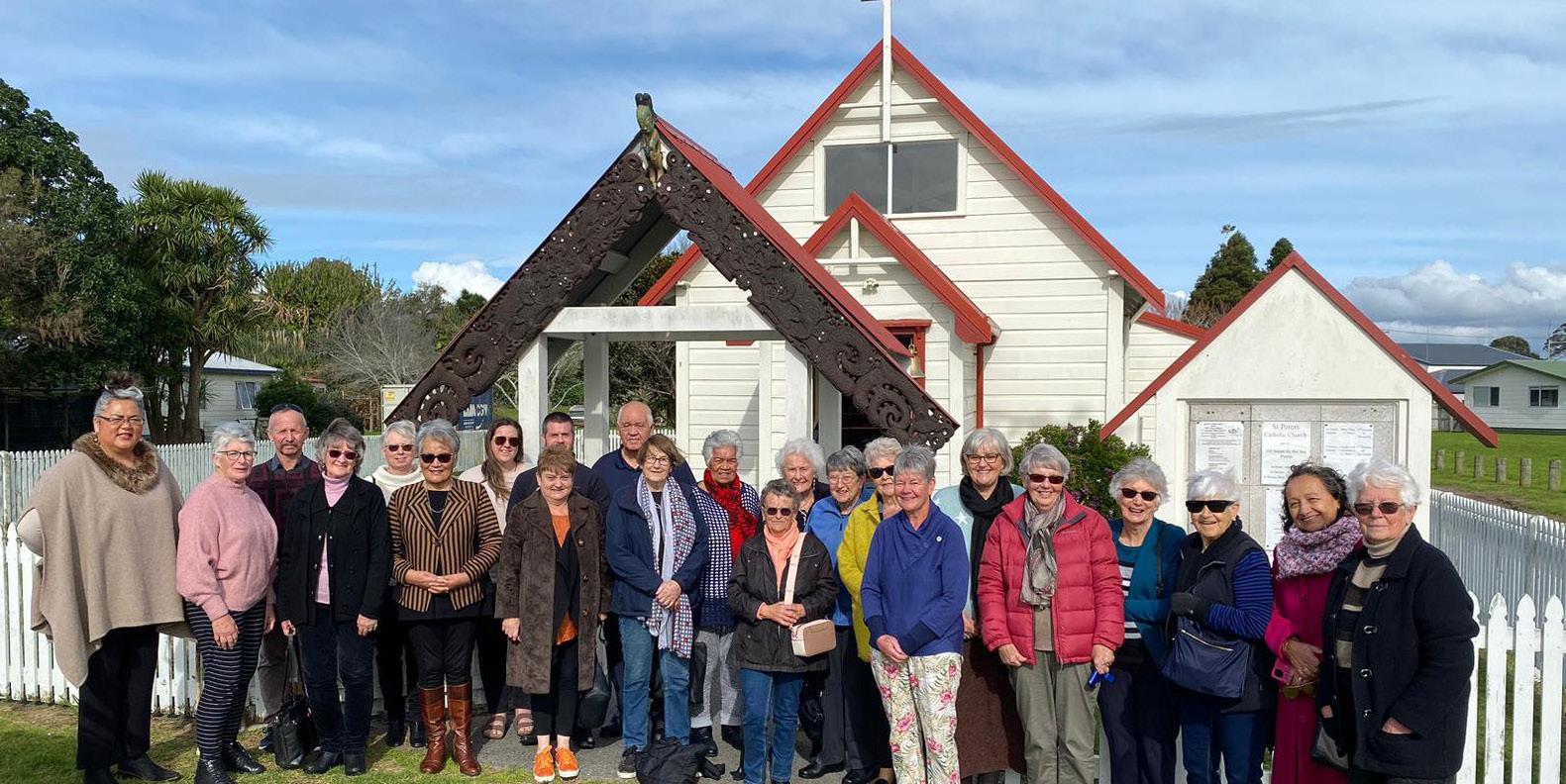
After the opening prayer Deacon Doug spoke of what an honour it was to be asked to present the event and of how it was a chance for him to personally thank the CWL for their donations made over the past years to the Maketū community.
Deacon Doug began his introduction by acknowledging how blessed we are to come together as family in the Church - for many present it was their first time to Maketū. We entered the Church to Mike Maason ringing the church’s bell as we joined in a welcome song. “There will be many hymns sung during the next 1 ½ hours,” Deacon explained. “It gives us time to refocus.” Deacon Doug’s daughter Tania was also present assisting in the song with her beautiful musical talents.
Deacon Doug handed the microphone to his lovely wife, Hariata, and she gave the group a historical timeline of events during which our Catholic faith was founded in New Zealand and discussion of those who brought the faith to
04
Maketū.
As most of us know, Bishop Pompallier arrived on our shores in Russell in 1835, and on March 11 1840 he said his first Mass in Tauranga. Everyone there that day - Including those present from Ngāti Whakaue of Maketū - received a Pompallier prayer book.
With the height of war between Ngāti Rangi and Te Arawa in 1841 Chief Tangaroa made his way to Russell to seek a priest for his people. Bishop Pompallier returned to the Bay of Plenty on August 22 1841, on the ship Sancta Maria, which he anchored off the coast of Maketū. As he came ashore, as the story has been handed down for many generations, he shocked the people of Maketū, being dressed all in purple including his stockings.
He was there for six days and baptised and confirmed the chief’s wife among others. By 1880, with priests coming and going over the previous few decades, many local Catholics were either meeting in homes or attending Anglican services. January 1887 saw Bishop Luck, accompanied by Father James Maden and Father Becker, visit Maketū. After thirty-five years without a priest in permanent residence they led the Rosary and the Litany of the Blessed Virgin was sung in Latin with around fifty people in attendance. Following this a committee was quickly formed and funds raised and one year later on January 1 1888, Bishop Luck consecrated St Peter’s Church, celebrated Mass, and confirmed twenty locals.
Father Van Dyke would travel from Tauranga to Te Puke on horseback, staying there Saturday night before continuing to Maketū for Sunday Mass at 10.30am once a month. Father Henry Boyd served during 1946 - 1967, baptising and confirming Hariata and presiding at her first Holy Communion, and he also married her and Doug.
1960 saw big changes for St Peters: the back wall was found to be rotting so with that needing to be fixed, it was the perfect time to make an extension to the back of the church. Coinciding with Vatican II the communion rails were removed as was the green paint of the interior.
In 2017 the Parish of All Saints by the Sea was amalgamated by Bishop Steve, including St Peter’s Maketū, St Patrick’s Te
Puke, and St Thomas More, Mount Maunganui (and later including Suzanne Aubert Primary School, with Mass being held weekly at their school). Hariata finished with special mention of all the memories the church contains, with many memories of the faithful servants who once prayed on these grounds: may they rest in peace.
Deacon Doug then took the mic to explain all the carvings, starting with the archway or gateway at the front of the church which we had walked through. Bishop Pompallier is represented prominently in the middle of this carving. Deacon Doug explained that both the gateway and the carvings inside the sanctuary on the altar, the lectern, and the presider’s chair were all carved by John Hathfield who dedicated these precious taonga to his mother, who was baptised in St Peter’s in 1928.
The altar represents a canoe with the spirals around the edges signifying the waves, and the crown of thorns, St Joseph, St Peter, and Mother Mary all feature in this most ornate of carvings, symbolising strong anchors combining all our peoples in faith from all lands that have come here. The lectern feature is John the Baptist professing the Word of God. His tattoos within the carving demonstrate his strength, with an octopus holding the lectern strong so the message is clear. The presider’s chair has four authoritative figures of our church history, and only right they are on the head’s chair: Matthew, Mark, Luke, and John.
The tabernacle was built around the same time as the church, with the same key element omitted: nails. It was removed from the church and classed as “missing” for many years, but in 2011 Doug overheard a conversation which led to the tabernacle being returned to its rightful place.
After the final closing prayer and blessing by Father Matthew our group joined the Rewi family and Mike for lunch. It is impossible to put 135 years (plus!) into a twopage article. The Rewi family are currently waiting for documentation from Rome, once this has been completed the diocese will be producing a booklet on the history of our oldest church complete with commentary and photos. We hope this has given you an insight into the rich history we contain within our very own diocese and we hope you look forward to reading more once this project is completed.
05 PHOTO SUPPLIED
CHRIST SEES YOUR HEART
BY JUANITA RAMAN
“Jesus knows your hearts. He sees our hearts. And he tells you today here in Lisbon, on this World Youth Day: ‘Be not afraid, be not afraid, take heart, be not afraid.’” – Pope Francis, for the 37th World Youth Day.
Before leaving for our pilgrimage, we received what could have been the best piece of advice from past Hamilton pilgrims: “Don’t sleep, dig deep.” These words became our motto for the month-long journey, which took us through a variety of living conditions ranging from a five-star hotel, a classroom floor, a tent, and the most luxurious: a park with two million other pilgrims! We were constantly being tested to our limits (physical, emotional, and mental) but through all of the long walks in the sun, hunger, and frustrations, we took heed of our motto’s wisdom and never stopped digging deep, staying positive, and trying to make the most out of the pilgrimage.
Maria Smith (St Columba’s, Frankton) was reminded of St Therese of Liseux’s quote, “I am not dying, I am entering into life.” We were called to detach from material things that we took for granted (e.g. a shower, a bed, electrical outlets) and enter into a space where we were completely empty. Empty and ready to receive what God wanted to pour into us.
On the first night of our trip, Bishop Michael Gielen advised us, “Get lost, for it is the best way to explore.” Geoffrey Smith (St Columba’s, Hamilton), felt like he was being called to get lost in God’s love. During our ten days in France we continued to get lost in God’s love (and sometimes geographically lost too - thank you Google Maps!). God took us on a wild journey around France, to places such as the Chapel of our Lady of the Miraculous Medal, St Vincent

06
De Paul Chapel (where we saw his incorrupt body), Notre Dame, Sacre Coeur, Le Puy, La Paray Monial (to see St Margaret where she had the first vision of the Sacred Heart), Ars (to see St John Vianney’s body, his home, and the beautiful chapel), and Toulouse (to see the tomb of St Thomas Aquinas).
God also took us back home to Fourvière, the place where Catholicism in Aotearoa stemmed from. Singing Mo Maria (the hymn that Bishop Pompallier wrote) in the basilica where the Marist brothers and missionaries prayed before coming to Oceania for their mission was moving for all of us. We also got to see the birthplace of Venerable Suzanne Aubert and the church where she was baptised. One overnight bus ride later we were in Fatima, Portugal! We were blessed enough to be able to stay in a hotel just two minutes away from the basilica. During our stay at Fatima I went to visit the Miracle of Santarem, which is home to a Eucharistic miracle. It was so surreal bringing my friends to a place that I had visited with my family fourteen years earlier. Seeing the miracle up close reminded me that Christ is alive, walking with us, and that no matter how long it has been he is always waiting for us to go to him. We then moved on to Pampilhosa da Serra, where we were hosted by the Coimbra Diocese for our “Days in the diocese” week. We were led by the Community of St John in catechesis, daily outings, and prayer, alongside pilgrim
groups from the USA, Taiwan, and France. On the final night the locals led us in an outdoor festival, filled with dancing, zeal, and the colourful Portuguese culture!

Then came World Youth Day week: a week filled with beautiful chaos. The city of Lisbon came alive with over two million pilgrims seeking opportunities to deepen their faith. “Seeing so many other people who believed in the same thing was so cool. To see the sheer amount of pilgrims walking to the venue from kilometres away was insane,” said Matthew Fransen (St Columbas, Hamilton). The buses, trains, and streets were filled to the brim with young Catholic people singing, chanting, and dancing.
A personal highlight for me was being able to attend the CHARIS event in the Estudio Luz, the stadium of light. A fitting name for a night filled with thousands of young people praising God in the light of his love alongside artists like Matt Maher and Israel Houghton. As a national group we attended holy hour with Bishop Robert Barron and got to hear Jason Evert and Chris Stefanick speak. We thanked the latter with a mighty haka!
At the evening vigil Pope Francis asked us to think about the people who have been a “ray of light for our lives.” People like grandparents, friends, priests, religious, catechists, and teachers. He reminded us that, in the way these people

07
were roots for our joy and faith, we are called to do the same for others.
His words took me back to our two days in Lourdes. Growing up in Malaysia, Our Lady of Lourdes was my home parish, so it was surreal to see the actual grotto where Mother Mary appeared - after having spent much time in my life praying at the replica with my mother, grandmothers, and aunties, the rays of light in my life. It served as a reminder for me that although this pilgrimage was giving me another chance to claim my faith for myself, I would not have been there without my family, whose prayers and actions helped to nurture my roots of joy, my Catholic faith.
We were blessed to be accompanied by Father Michael Therese, Bishop Michael Gielen, Father Tien Ciao, and Father Monty Bamford who were great sources of spiritual direction, knowledge - and banter! They were constantly encouraging us to use our God-given gifts and talents and to become aware of the ways in which the Spirit was moving. As a national group we had the opportunity to lead the music for Mass at Fatima and at our “Rise Up” catechesis during World Youth Day week. We also got to serve at the Mass in Lourdes and the rosary processions in both Lourdes and Fatima. Seeing our Kiwi priests celebrating Mass at the beautiful holy sites that we visited was a great source of joy for us.
Being a young Catholic in today’s climate is not easy. Ciara Claridge (Cambridge) reminded us that events like World Youth Day help to “bring young people together to show us that we are not small in number, and it is so, so beautiful.” We all left World Youth Day feeling alive, on fire, and proud to be Catholic.
On the final day of our pilgrimage Pope Francis reminded us that it was not him who was looking at us, but Christ. A Christ who “knows your hearts. He sees your hearts. And he tells you today here in Lisbon, on this World Youth Day: ‘Be not afraid, take heart, be not afraid’.” If anyone is considering this invitation, do not be afraid to take the leap with Christ, who knows you, sees you, and loves you. He will take you on the adventure of a lifetime.
Juanita Raman is from the Cathedral Parish. The next WYD will be held in 2027 in Seoul, South Korea.
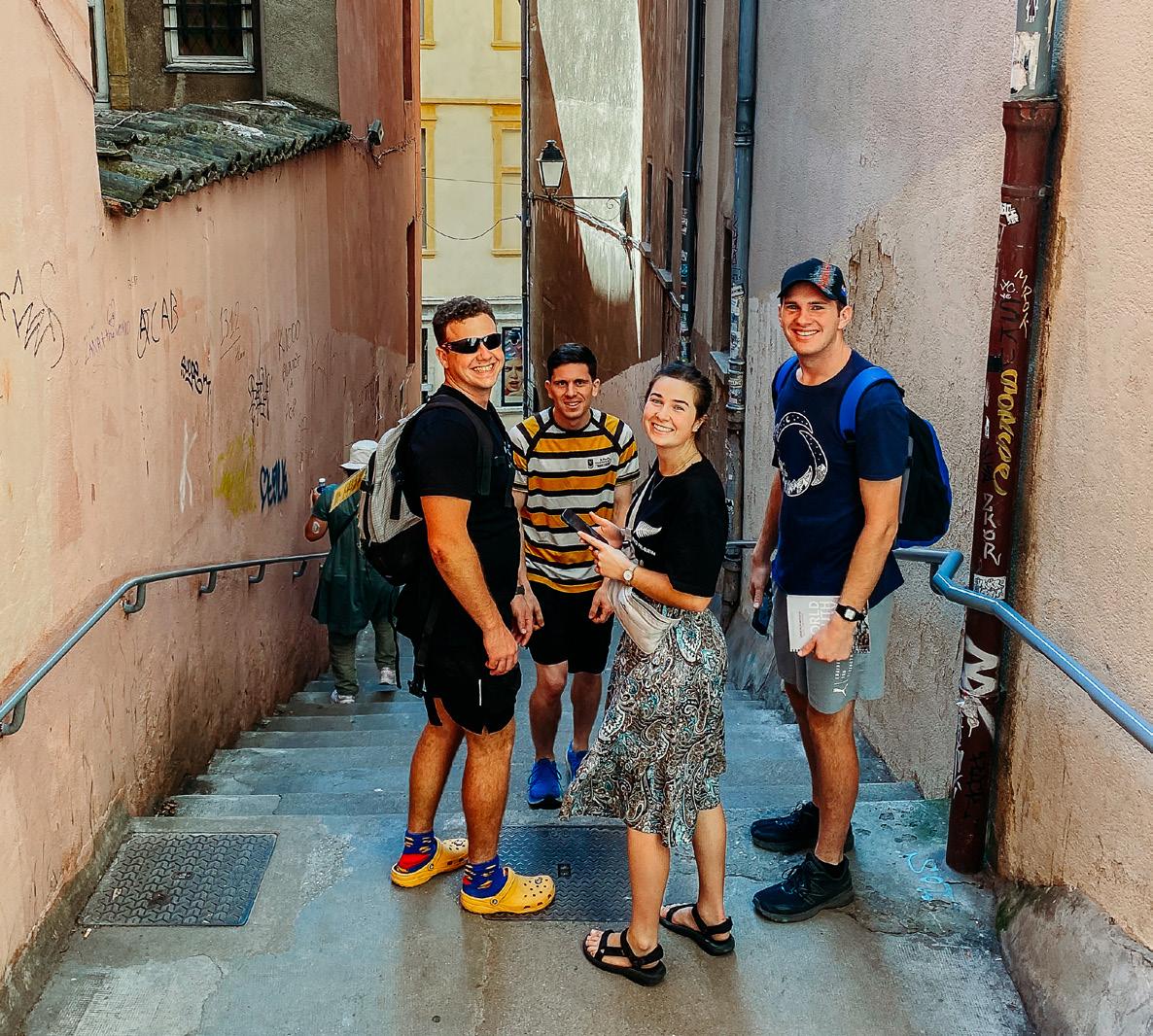
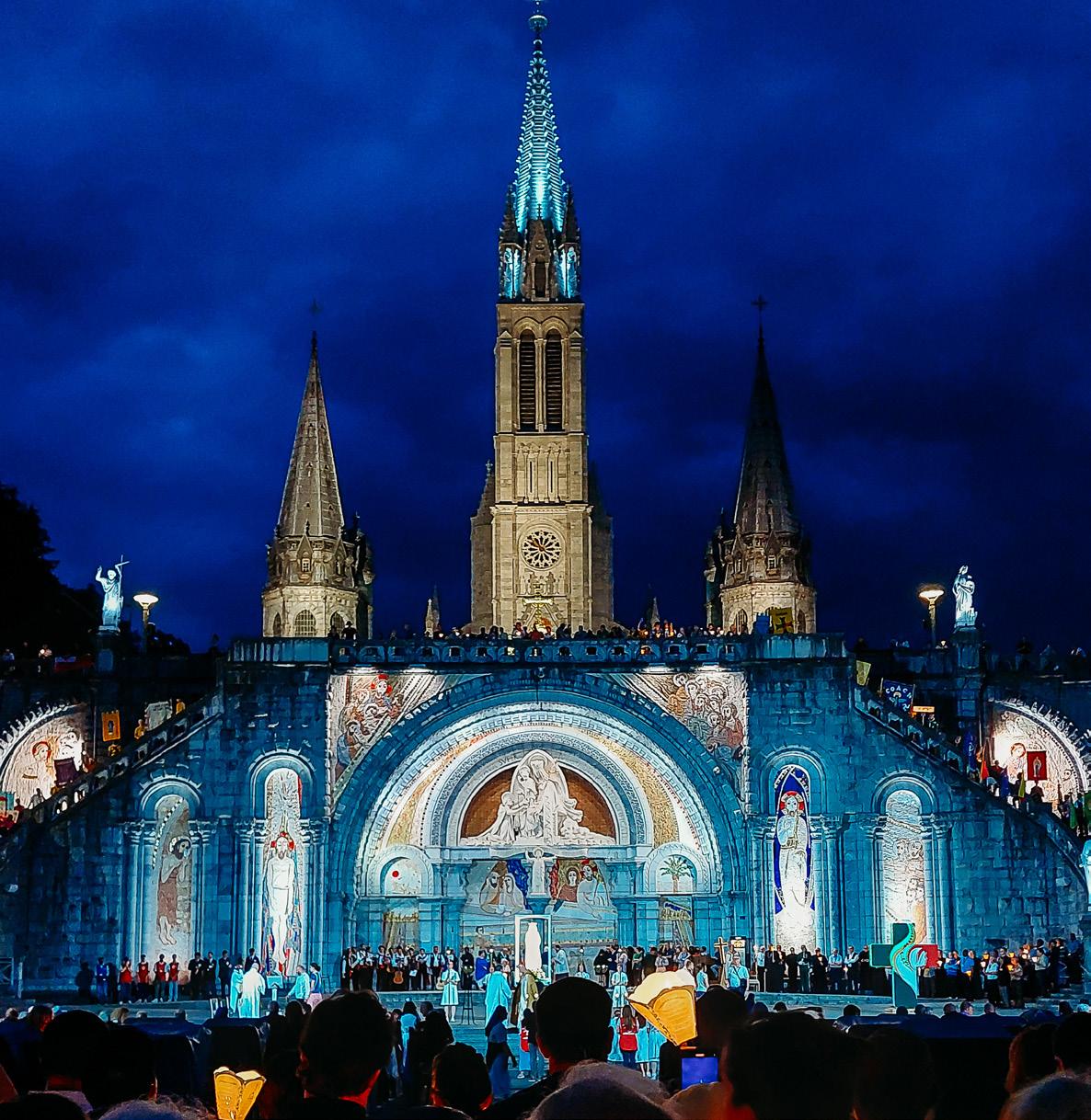
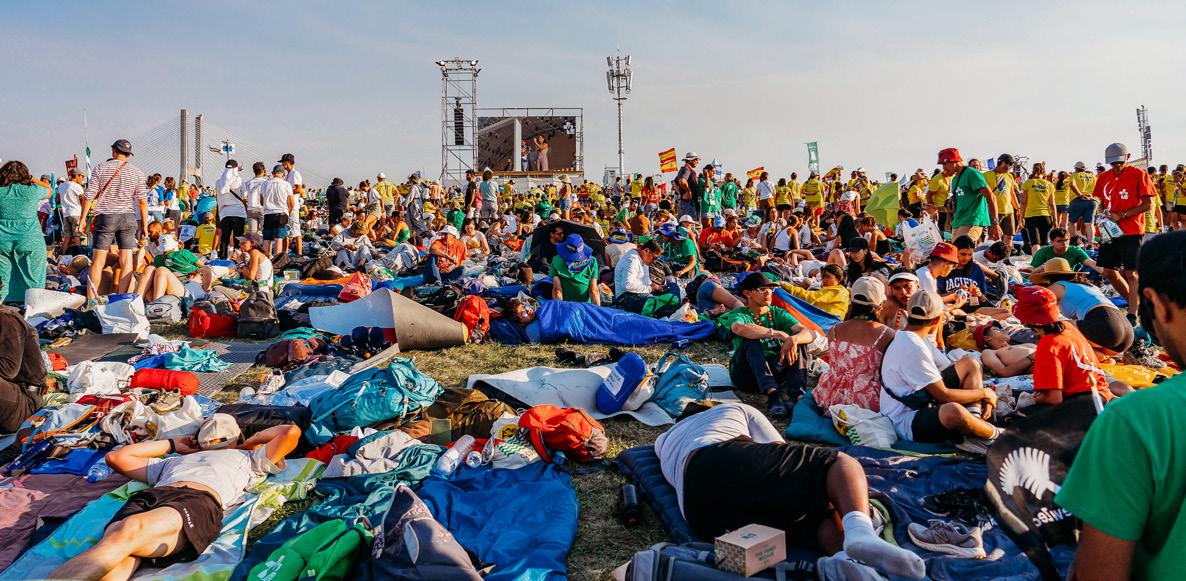
TEO 08
PHOTOS SUPPLIED BY JUANITA RAMAN, GEOFFREY SMITH AND WINSTON
QUIZ ANSWERS FROM PAGE 3:
1. Answers include: zucchetto, biretta, mitre, saturno, qob, galero

2. Father Isaac Fransen

3. 1980
4. There are 73 books in the Catholic Church’s canon - the Protestant canon omits some books, counting 66.
5. Jacob
6. French - the English translation was published two years later.
09
LIGHTING FIRES AT AQUINAS
BY SUSAN VAN ZYL ACTING PRINCIPAL, AQUINAS COLLEGE
Belong. Believe. Become.
The phrase “Belong, believe, become” reflects evangelisation at Aquinas College, Tauranga, and has been a call to us to re-evaluate how we are providing experiences for our students to encounter Christ. Pope Francis has suggested that it is a time of a new Pentecost for our youth where many have been “sacramentalised but not evangelised” as Australian priest Father Ken Barker, MGL, puts it. While over 95% of our students are “preference students” there continues to be a vast range of faith experiences among them and we need to be intentional about meeting our students where they are while also inviting them further. Pope Francis’ Christus Vivit (Christ is Alive) says “the community has an important role to play in the accompaniment of young people; it should feel collectively responsible for accepting, motivating, encouraging, and challenging them” (243).
An important way of meeting students where they are and then inviting them into a living relationship with Christ through reigniting the fire of the Holy Spirit has been the development across years 11 - 13 of our Intentional Discipleship Pathway (IDP). The purpose of this pathway is to both focus on the curriculum and provide space for the “evangelisation cycle” (described below). Students who elect - at the end of Year 10 following an invitation after their retreat that year - to be in these classes are at varying places on a faith continuum but are seeking to understand where or if Christ is currently working in their life.
We’ve found that students are open and willing to be vulnerable in these spaces and staff ensure there is a safe environment for sharing as classes explore different topics. Students are supported to be a witness of faith to provide

10
EACH YEAR LEVEL HAS A DIFFERENT FOCUS: YEAR 11 - DISCIPLESHIP CLASS; YEAR 12 - YOUTH MINISTRY CLASS; AND YEAR 13 - MISSION AND MINISTRY CLASS
peer-with-peer ministry, leading retreats for younger students, ministry which is grounded in the truth of the Gospels so that students in the IDP are equipped for mission as disciples of Christ in other contexts. This pathway is now in its fourth year and we currently have over eighty students across the three year levels.
Teachers of this pathway, along with myself as the IDP Leader, continue to seek opportunities to nourish our own faith by attending development and learning opportunities in New Zealand and Australia. The role of IDP Leader also includes building connections and relationships with other leaders to support the programme, and a key part of this over the past few years has been establishing a connection with Cedric Piggin at Sancta Maria College and a much more recent connection with Brendan Bergin at Marcellin College.


This year we had an exciting opportunity for our Year 12 “Youth Ministry” students to participate in a twoday Oceania New Zealand hub experience at Sancta Maria College in Auckland. This event connected people from Australia, Fiji, Tonga, Samoa, Papua New Guinea, Solomon Islands, and New Zealand, with a blend of online sessions, music ministry, and a day with the Auckland NET team. Students also listened to past Aquinas head student Sam Brebner share his thoughts on living a life of purpose. This was a very powerful experience and students enjoyed the opportunity to share their love of Christ with others. We are looking forward to Sancta Maria visiting Aquinas in term four to continue to connect on our journey of faith.
During the term three holidays a group from Marcellin College joined our Year 13 “Mission and Ministry” students for a two-day retreat. This was a special occasion to join in a sense of community and to reflect on how a living relationship with Christ is present in our lives. We are blessed to have formed these connections and to work alongside these other teachers who are so dedicated to sharing their love of Christ with others. It is these shared experiences that also strengthen us and encourage us in our mission, which is to accompany our students on their journey of faith.
11
FROM VIETNAM TO THE WAIKATO
BY KIRSTY MUIR
Nhat and Hung might be from two separate dioceses in Vietnam, but both gave me a similar detailed account, which proved to be quite the learning curve, into the life of a Catholic in Vietnam.
Recently the diocese ran its annual seminary appeal. With the ordination of Father Adam Kirkeby in 2022, it means we now have no current seminarians, which may leave you wondering - why the appeal. We continue to pray that young men in New Zealand will spend time seriously discerning their vocations. Meanwhile, we have two Vietnamese students who have already taken the big step to discern a potential calling to the priesthood. Given their desire to enter the seminary, they are currently enrolled in Waikato University to strengthen their English. As with any enquirer to the seminary, they are carefully discerning a call to priesthood, and at any point either the man himself
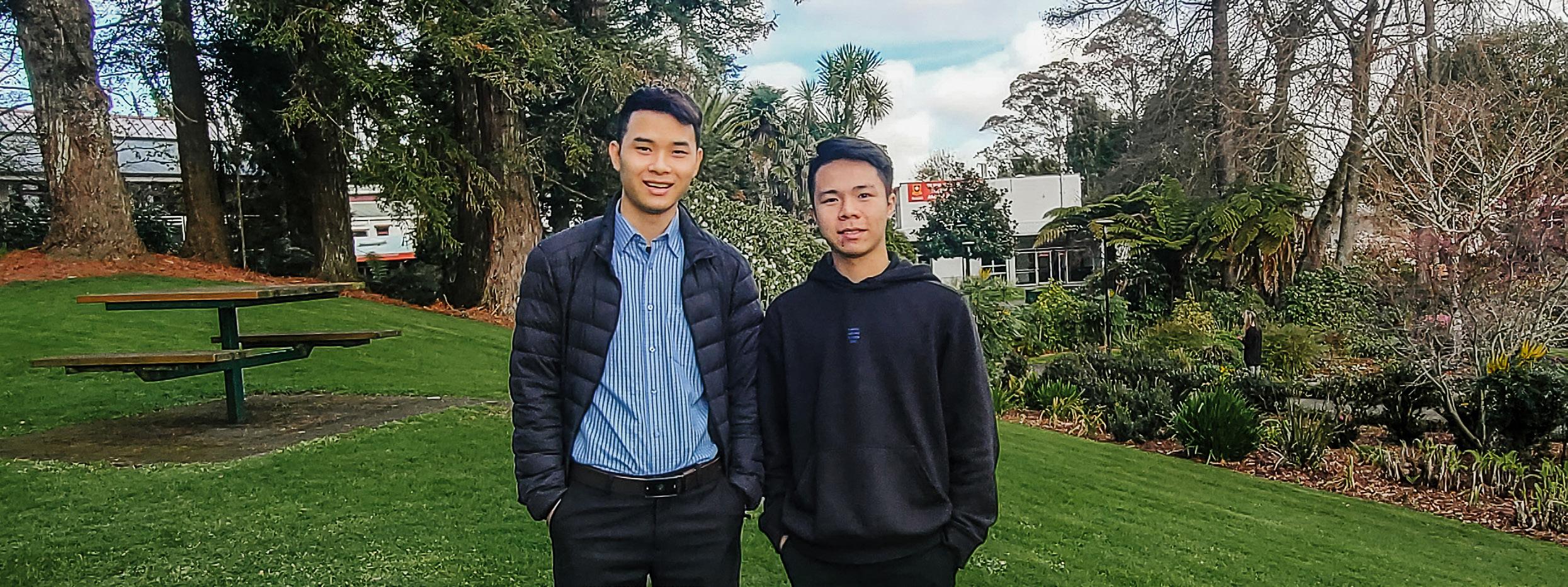
or the Church may discern that priesthood is not for them - this is not a failure of the process or in the candidate, but a success.
Seminarians are supported by their individual diocese, so your kind donations support them in their studies and we can also continue to contribute to the upkeep of Holy Cross Seminary, where, God willing, these young men will be living and studying at some point.
On a lovely sunny weekday afternoon, during their lecture lunch break, I got the opportunity to hit the campus and get
12
PHOTOS SUPPLIED
to know our students, Nhat Long Cao and Hung Van Ha.
Nhat and Hung are from two separate dioceses in Vietnam, but both gave me a similar account, which proved to be quite the learning curve, of the life of a Catholic in Vietnam. Daily Mass is expected and Masses can start any time from 4.30a.m. with up to 2000 people. A lot of scheduled Mass times mean there are no excuses for not attending. For me, coming from the culture in New Zealand where our diocesan priests are so stretched with their time, I couldn’t understand how the priests can offer so many Masses per day. Once Nhat showed me a photo of a recent intake for the entry exam to enter seminarian studies I understood. The photo looked more like the size of our Sunday Mass congregation than a picture of the faces of so many men who have discerned and answered God’s calling. With 150 sitting the entry exam only around thirty will be acceptedif you don’t make the cut, then it’s a two-year wait to sit the exam again. However once you are older than 28, that is it, you can no longer sit the exam. Given these young men are still well within the age bracket to enter seminary in Vietnam we are extremely grateful to the dioceses of Vinh and Ha Tinh for the gift of these two young men. They are ready to serve the Lord in New Zealand and are more than happy to be here for the people of the Hamilton Diocese.
Nhat, confirmed with the name of St Joseph, and Hung, St Peter, didn’t know each other before coming to New Zealand but now are as close as brothers. Nhat has one brother and sister back home while Hung only has sisters,
four of them! One of Hung’s cousins has just celebrated his third year as a priest and in that same family two other brothers are priests.
When I asked what the biggest challenge was I assumed it would be the English language. It turns out it’s the cold, given “back home” it is currently sitting around 40 - 43 degrees.

We are blessed to have Father Matt Gibson and Father Isaac Fransen in our diocese who have taken these men under their wing. Ordained in the past five years, the seminarian years are still fresh in these priests’ minds, and their time discerning priesthood also. There has been plenty of time for Nhat and Hung to quiz them over any concerns between road trips and learning to ski. Fathers Matt and Isaac took them on a trip to Gisborne where they visited Rere Falls, the Eastwoodhill Arboretum, Tokomaru Bay, and Tolaga Bay Wharf, and spoke to a Year 11 class at Campion College.
Recently they travelled south to Invercargill to the double ordination for the Diocese of Dunedin of Joseph Long Van Nguyen and John the Baptist Suu Van Nguyen. These new priests have a similar story, arriving here not knowing one another and speaking very little English, so perhaps in this moment we see a glimpse into the future of Nhat and Hung’s story.
When you are next at St Columba’s or the cathedral make
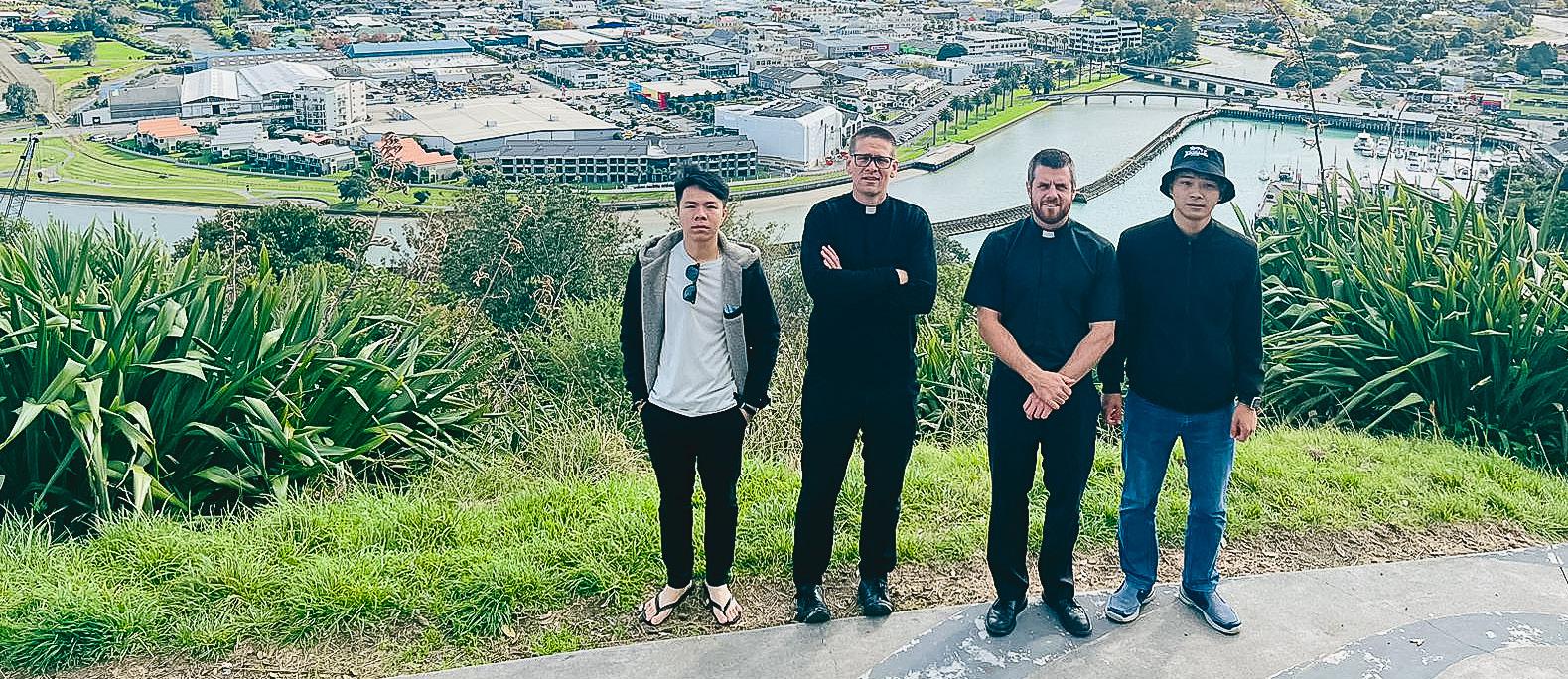
13
sure you introduce yourself to these young men. You might find Nhat behind the piano at a Sunday Mass and Hung often assists Fr Isaac with the exposition for young adults on a Friday night. It was an absolute pleasure to get to know them, and I know you will all enjoy their companionship too.
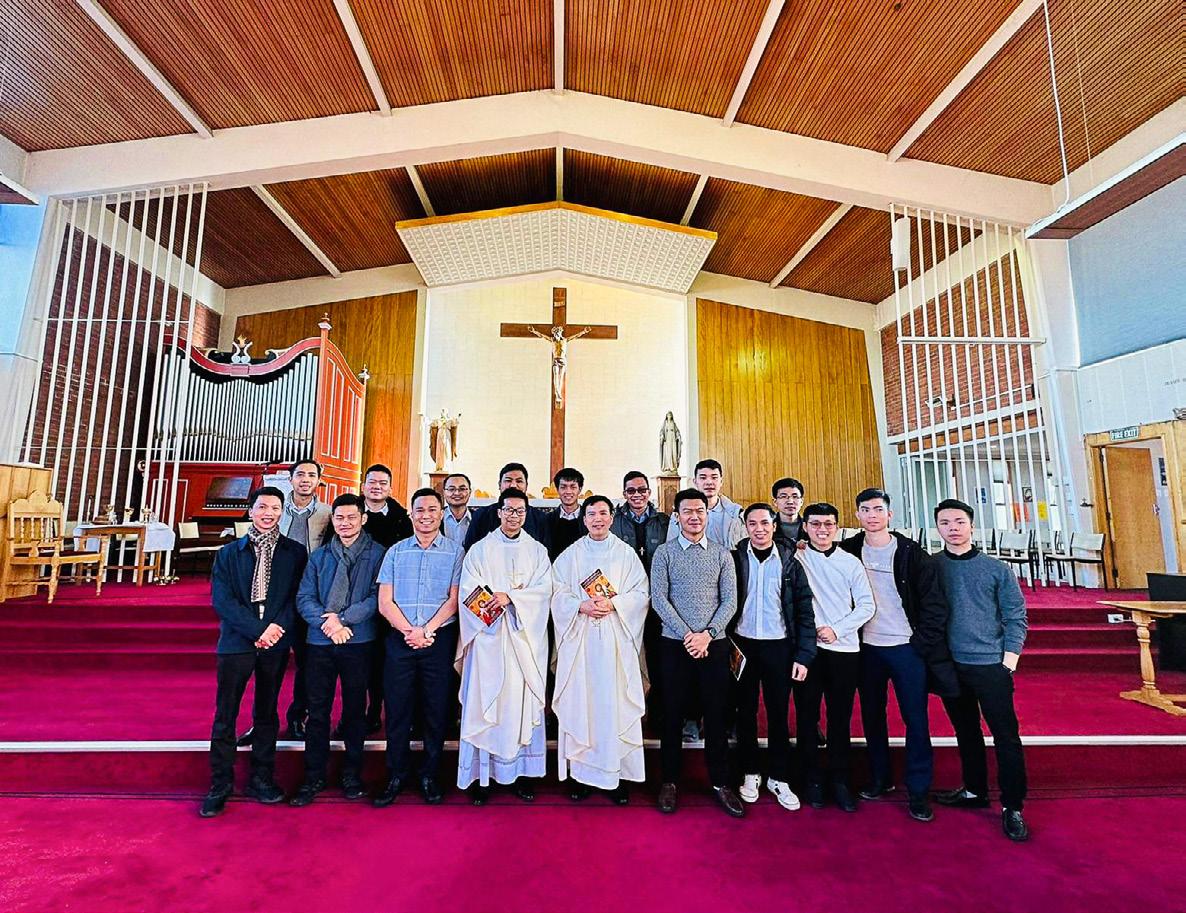
We hope by introducing them to you, you will keep them in your prayers, and we can all perhaps joyfully celebrate, with God’s grace, in eight years at their ordination.



14
PAEROA FAMILY GROUP
BY KIRSTY MUIR
Celebrating 35 years!
The Passionist Family Group in New Zealand has been bringing families together for thirty-five years. The movement started in a Sydney parish by Passionist Priest Peter McGrath fifty years ago with a vision to support families in faith. From there, it came to a small rural town in our very own diocese, Paeroa.
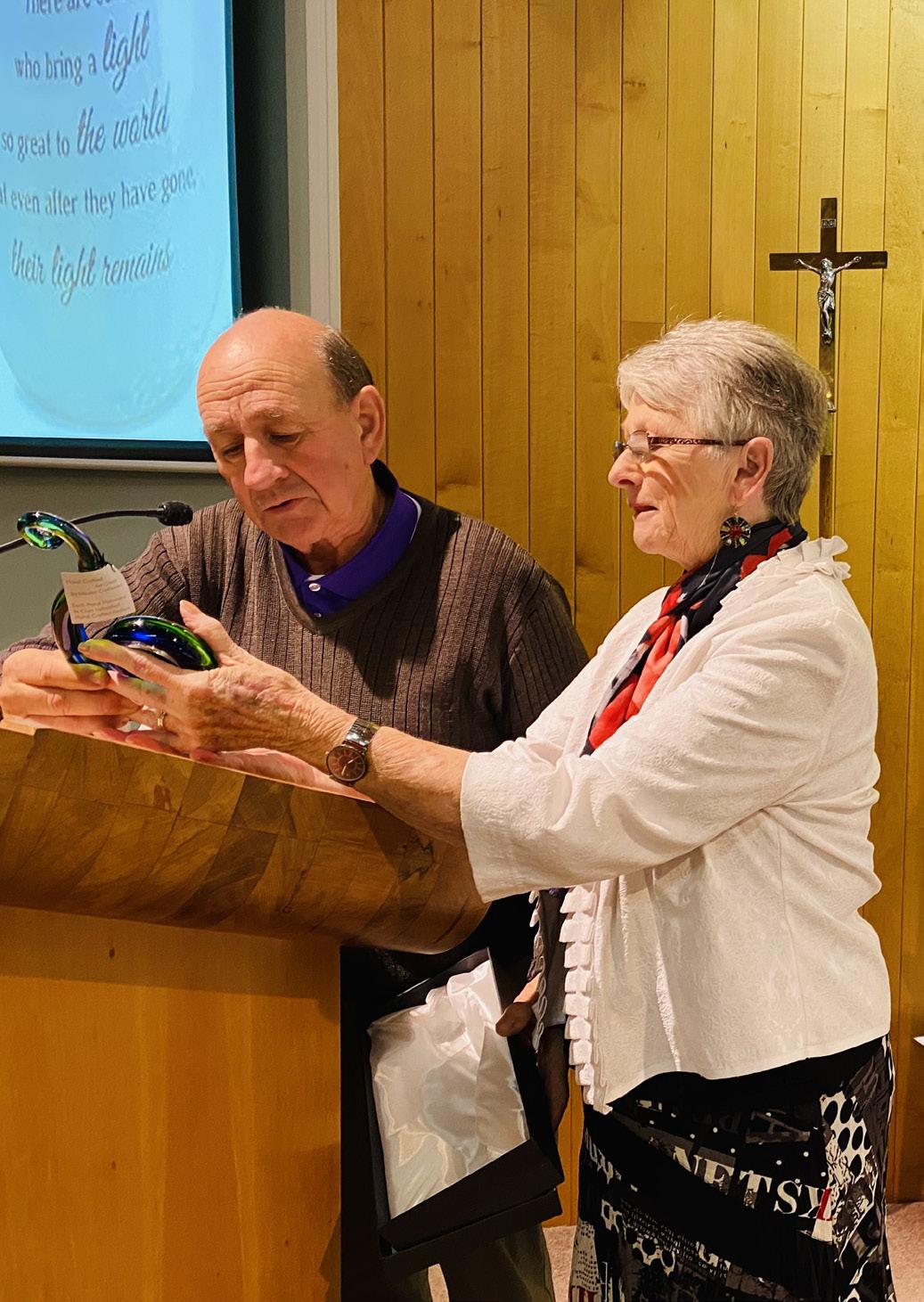
Father Purcell (RIP) once said, “As parish priest, I am very grateful for these groups and wish them well. Long may they be part of our parish life.” As they go about celebrating the thirty-five years milestone I think it is safe to say his prayers were answered. Paeroa has a very committed team, at the centre Charlie and Maggie Gribble, who are the longest serving parish coordinators of the Passionist Family Group movement.
Father McGrath once said, “Passionist Family Groups don’t take away the pain and struggles of life. Rather, they help us to live as followers of Jesus Christ.” The PFG has certainly felt the struggle during and after the pandemic and the busy-ness of the modern world as attendance in churches has dropped and fewer families with children are involved. People might suggest the PFG has had its day, but Paul Traynor, national coordinator of Aotearoa, says it’s just the contrary, explaining that the aim of the group is to build communities of trust that support families day by day. He sees the need as greater now than previously, so that people can connect with each other and their families. He suggests that developing a sense that being family to one another brings an openness to embrace the call to be like Jesus. “Passionist Family Groups help us to see God at work in the ordinary experiences of our lives.”
Celebrating thirty-five years is a wonderful milestone for the group and a chance to move forward in “this post-
Covid world.” It is a chance to remember all those who have been involved and have supported the movement and of course to remember those who have passed. It’s a celebration acknowledging an abundance of memories and people.
Head to www.passionistfamily.org.nz to start or restart a group in your parish.
15
PHOTO SUPPLIED: CHARLIE AND MAGGIE GRIBBLE READ THE INSCRIPTION ON THE TAONGA, WHICH WAS PRESENTED TO THE GROUP ON THE EVENING
THRIVING LIVES
BY BEN SOKIMI FUNDRAISING COMMUNICATIONS ASSISTANT, CARITAS AOTEAROA NEW ZEALAND
In the wake of economic and health challenges brought on by the COVID-19 pandemic, and in the face of the growing impact of climate change, Caritas partners across the Asia-Pacific are working to provide food and water security, build healthy lifestyles, strengthen income-earning opportunities and support “thriving lives”.
This is being done through He Oranga Taurikura –A Thriving Life, a five-year partnership between Caritas Aotearoa New Zealand and the New Zealand Aid Programme. For every dollar that Caritas supporters provide to the programme, the New Zealand Government will match it with three dollars.
Working through nine established community organisations, He Oranga Taurikura – A Thriving Life aims to reach over 90 000 people in Cambodia, Fiji, Kiribati, Papua New Guinea, Solomon Islands, Timor-Leste, and Tonga.
CASE STUDIES
Farming for the future in Fiji
Tutu Rural Training Centre on Taveuni Island in Fiji is recognised as a national leader in providing agricultural, business, and life skills to young farmers, with an underlying Marian spirituality.
A meeting midway through last year of young farmers at Tutu RTC highlighted the ongoing economic and social impacts of COVID-19, and how rural areas were supporting people returning from urban areas.

16
PHOTO SUPPLIED: A MEETING MIDWAY THROUGH LAST YEAR OF YOUNG FARMERS AT TUTU RTC
Tutu student Apakuki formed a group of six young farmers from his home village. Each of these young farmers initiated a planting programme for cash crops yaqona (used to make kava) and dalo (taro), based on what Apakuki had learned at Tutu.
Pate from Korotasere in Vanua Levu had both his parents return to his village from living in Suva. His mother had lost her job as a sports journalist. When schools re-opened, his parents returned to Suva with their younger children. But while in the village they planted a thousand cassava plants, with the harvested cassava expected to be sent to the family in Suva.
Both of these young farmers agreed that a lot of people are falling into the trap of thinking about quick money, which they did not consider good. The COVID-19 crisis has taught them that they need to have many baskets and not rely just on one thing such as tourism. They concluded, “People before used to look down on us as farmers, now we are the ones who the people from the urban areas look up to.”
He Oranga Taurikura Fiji has supported the Tutu Rural Training Centre in upgrading and maintaining their energy and water systems. This critical work will not only enhance the sustainability of agriculture training programmes but also empower the community to become more resilient against the devastating impacts of storms and climate change.
The repurposing of existing buildings on-site has made it possible to expand student numbers and offer a comprehensive life-skills programme for single women.
Empowering women in the Solomon Islands
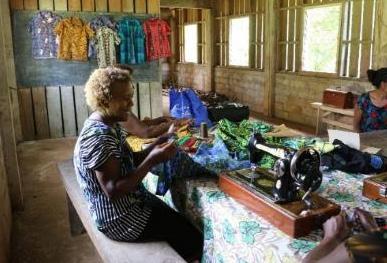
He Oranga Taurikura Solomon Islands is working to strengthen training provided by ten rural training centres through the umbrella organisation Solomon Islands Association of Vocational and Rural Training Centres.
In one example of “training the trainers,” twenty women attended a combined financial literacy and sewing course in the capital Honiara in mid-2022. Training was provided for ten life skills teachers or instructors from the remote rural training centres along with ten women from the community near each centre.
In the first week the women learnt basic financial knowledge and skills to manage their finances and those of the organisation they represent. The second week was devoted to elevating their knowledge and skills in sewing, such as learning about pattern making, measurement and making complete products such as dresses and shirts.
Women community members learn to sew shirts at the Ngaligaragara RTC, taught by two trainers who attended the Honiara training.
At the Ngaligaragara Rural Training Centre in the Malaita Province, Caroline Kofuli (life skills teacher) and Elsie Tony (community representative) returned from their training in the capital Honiara and are now teaching other women in their community to sew. Many of these women have gone from having no knowledge of sewing garments to being able to complete a shirt or dress every week. These items can then be sold to raise money for the women and their families. Caroline and Elsie are also sharing their learnings in financial literacy, helping the women in the community manage the money they are earning through these sales, and ensuring they are empowered to take part in financial decision-making in their homes and community groups.
Your continued support for He Oranga Taurikura – A Thriving Life empowers individuals and communities and will have a life-long impact. Stand with us as we foster thriving lives together.
For more information or to support the work of Caritas, visit caritas.org.nz
PHOTO SUPPLIED 17
THANK YOU
BY BETTY-ANN KAMP
COMMON GOOD FOUNDATION CYCLONE APPEAL 2023
Cyclone Gabrielle is said to have been the most significant weather event in New Zealand for over a century. We at Common Good Foundation moved into immediate action to raise funds in support of the people impacted by the storm in the Tairawhiti region. Within days we had transported practical items such as socks, underwear, and petrol cans to the rural communities badly affected by the floods.
The response from people in our diocese was heart-warming with $40,000 raised within six weeks. We are pleased to advise these funds were distributed to the following organisations who did amazing work on the ground in Tairawhiti supporting those hardest hit by the devastating weather events: St Vincent de Paul, Gisborne, providing whiteware to help people re-establish their homes; The House of Breakthrough - Te Hahi, funds provided for foodbanks and practical help for those families displaced

from their homes; Gizzy Kai Rescue, kai distribution and general wrap-around social support; The Nest Collective, supporting families with babies and young children who have been impacted by the floods, via local midwives and social workers; Tairāwhiti Community Law Centre, supporting flood victims while they negotiated property issues, insurance, and other flood-related problems.
Common Good Foundation would like to take the opportunity to thank all the parishioners in our Hamilton Diocese for responding to our call to action earlier this year and generously donating to our appeal. A special mention must also be made to the Christchurch Diocese who also provided funds towards our appeal.
THANK YOU FOR YOUR SUPPORT FOR THE CARING SUNDAY APPEAL 2023
Common Good Foundation recognises this year is a challenging year for low-income families due to the rising cost of living. We are seeing a greater need for food, budgeting support, and practical help for the most vulnerable through charities working within our diocese. Mental health issues are also a growing trend following the recent weather events and the after-effects of COVID-19.
No one can flourish in poverty. This year Common Good Foundation is looking to fund charities reaching out to families and communities who struggle with the effects of poverty and hardship. Our goal is to work with these organisations to support those in our diocese in targeted practical ways.
Our priority areas for support continue to focus on improving the lives of the most vulnerable, to keep families
LEFT AND OVER: PHOTOS SUPPLIED 18
safe and provide them with the basic necessities along with budgeting advice. Our at-risk youth need to be given opportunities to make good decisions and develop employment skills through courses offered in their local areas. We also wish to provide support for older people, advocating for those struggling so that all can become independent.
Common Good Foundation is also greatly supportive of parish-based Initiatives - which are prioritised in the allocation of funds - and welcomes applications from concerned parishioners throughout the Hamilton Diocese who may already see a need or who are already offering some support to others.

All information relating to the funding process can be found online at: www.commongood.org.nz/support-others/grants

For further information on Common Good Foundation and the wonderful work we are doing in the Hamilton Diocese please visit our website www.commongood. org.nz or our Facebook page.

19
COMPETITION AND CONNECTION
BY LEON ROBERSON, AQUINAS COLLEGE DRS
The annual Chanel Shield competition was hosted by Aquinas College this year, taking place on August 18 and 19.
So, what is Chanel Shield?
From the Aquinas archives: “The Chanel Shield is a competition held annually and involves the five Catholic colleges from the Diocese of Hamilton: Campion College from Gisborne, St John’s College from Hamilton, Sacred Heart Girls’ College from Hamilton, John Paul College from Rotorua, and Tauranga’s Aquinas College. The inaugural Chanel Shield competition was held in 1987 and was initiated by Bishop Edward Gaines, the bishop of the Hamilton Diocese at that time. Bishop Edward envisioned the Chanel Shield as being a way to bring the four Catholic Colleges of the time together to connect, collaborate, compete, and deepen their faith. Bishop Edward named the Chanel Shield in honour of the patron saint of the diocese, Peter Chanel, who was a French-born missionary priest who worked in the Pacific region in the 19th century.” The gathering begins with a pōhiri followed by Mass, with representatives from each of the colleges being involved in the various ministries of the Mass. The competition then commences.
The events begin with the Māori perspective speech, junior and senior Bible readings, and junior and senior speeches. The first two debating teams receive their moot and begin their preparations. Each debate provides a winner and points for each team, with the two highest-scoring teams meeting in the final which takes place on Saturday morning. The impromptu speech is a challenging event and stretches students in their ability to construct a speech, based on a theme from the Bible, that they have been given ten minutes to prepare.

Friday concludes with a beautiful dinner, surrounded by lively chatter and the joy of each other’s company. Saturday morning commences with morning prayer and then the exciting Bible quiz via Kahoot. The drama is then presented by each school, a hotly contested event. Finally, the Chanel Shield concludes with the junior and senior poetry recital and the debate final. The last event to take place is the prizegiving, followed by prayer and blessing and then the visiting schools are farewelled with a packed lunch for the journey.
This year St John’s College Hamilton won the Chanel Shield, with the remaining four schools being separated by a mere three points. Congratulations to St John’s. The Chanel Shield is a wonderful gathering of colleges that creates new friendships, fosters laughter and fun, and of course includes serious competition.
CATHOLIC WOMEN’S LEAGUE BY
CLARE GALLAGHER CONFERENCE
CONVENOR
Hamilton Diocese’s nine branches and sixty members of the Catholic Women’s League earlier this year enjoyed one-and-a-half days of renewing friendships, listening to speakers, a Mass, and of course dinner and entertainment. The Matamata CWL branch hosted the conference on March 31 and April 1 at Holy Angels Parish, Matamata.
The conference was opened by Monsignor Leonard Danvers, parish priest of Holy Angels. Diocesan CWL president Moira Kilbride gave her annual report, followed by mission, WUCWO, and social issues reports. Roles remained unchanged following the election of officers, with the vacant position of vice-president being filled by Clare Gallagher, Matamata president.
20
PHOTO SUPPLIED (LEFT): A COMPETITOR IN ACTION
PHOTO SUPPLIED (PAGE 21, TOP): SUSAN DICKSON, FORMER NATIONAL PRESIDENT OF CWL, ADDRESSES THE CONFERENCE ATTENDEES
National president Susan Dickson, who has since retired from the role, gave a keynote talk and spoke mainly about the importance of using technology, such as the CWL Facebook page, to reach out to and engage with the wider group.
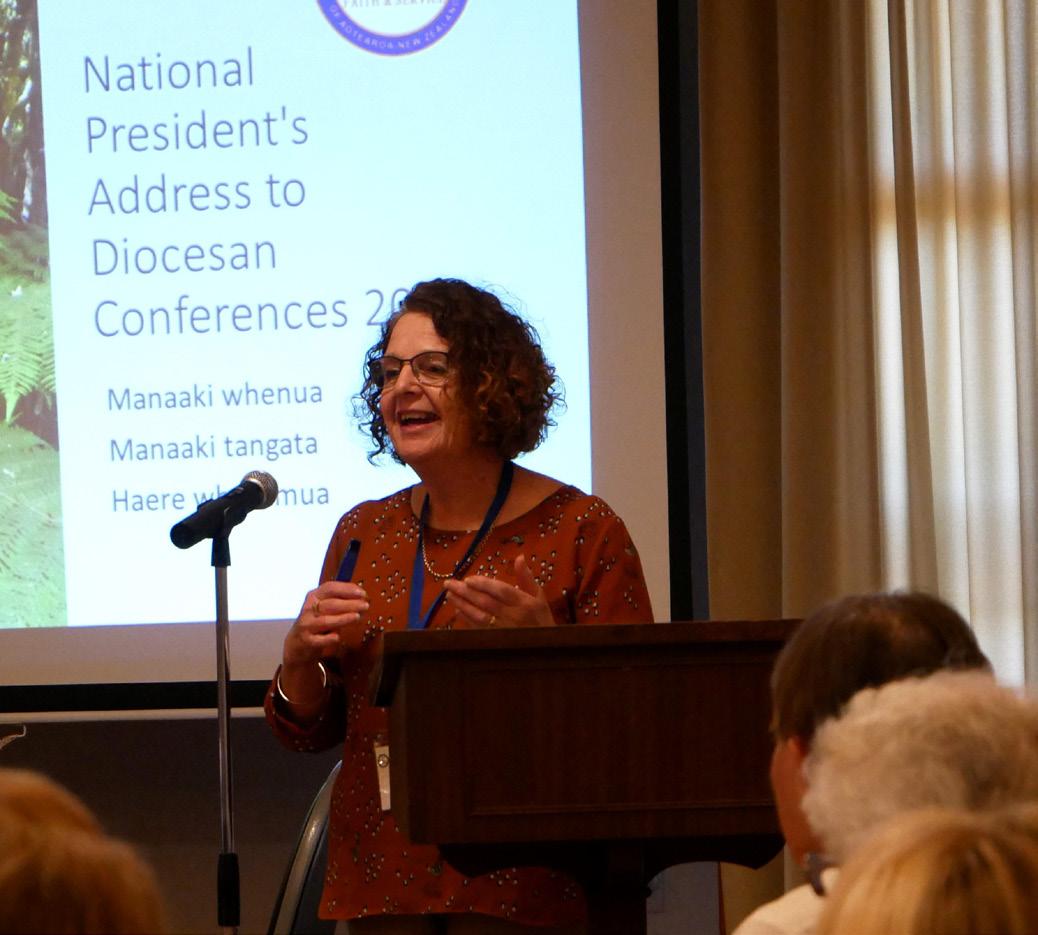
The day finished with a mix and mingle, dinner, and entertainment.
The following day started with Mass celebrated by the diocesan CWL chaplain, Monsignor Frank Eggleton. During Mass a remembrance candle was lit to acknowledge the passing of members over the past year. Guest speaker Louisa Palmer, from the Matamata-Piako District Council, spoke about waste and the environment. After questions from the floor, it was raffle draw time.
The conference concluded with a talk from Monsignor Eggleton on how CWL members within their own parishes need to extend a welcome and friendship to other ethnicities, not just with a smile and a nod, but to take the time to speak, include, and sit beside these folk.
The CWL’s Refresh, Refocus, Restart vision remains the same as when the CWL was first formed in 1932 by the then Bishop of Auckland, Bishop Liston.
2024’s conference will be hosted by the Tokoroa branch.

KAKE ORANGA HĀHI KATORIKA CATHOLIC FAMILY SUPPORT SERVICES ROTORUA
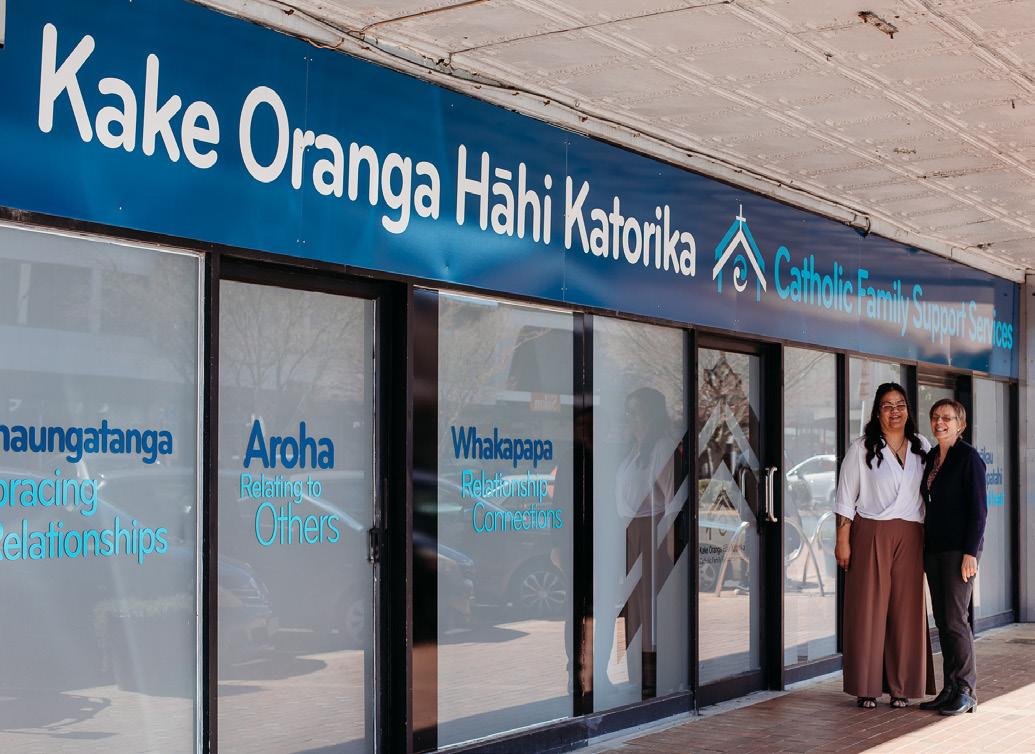 BY TAILA BURTON-GOLLOP
BY TAILA BURTON-GOLLOP
Kake Oranga Hāhi Katorika Catholic Family Support Services was opened and blessed in Rotorua on August 31. (In what will be the main office space) more than 60 people gathered, to celebrate this wonderful occasion. The newly finished space is located in the middle of Rotorua and will offer support to the community, CFSS working alongside other community groups to do their best to ensure that people in need are able to recieve the help and support they seek. Kake Oranga Hāhi Katorika was blessed, speeches were given, and kai was shared, all in celebration of what this space will bring to the community.
21
RIGHT TOP: RENEE (CFSS) AND BETTY-ANN (COMMON GOOD FOUNDATION) RIGHT BOTTOM: JOHN COULAM, BOARD CHAIR, ADDRESSES THE ATTENDEES
WHĀNGAIHIA TE NGĀKAU –RONGOHIA TE WAIRUA
BY EMALENE CULL PRINCIPAL, ST JOSEPH’S CATHOLIC SCHOOL, PAEROA
Nourishing the soul – Encountering the Spirit to experience, discuss, and learn more about Māori spirituality and Catholicism and how these both challenge and strengthen one another. Our hīkoi took us first to Hato Pāora College, near Feilding, and then to Te Rau Aroha Diocesan Centre in Palmerston North.
The strong sound of the haka pōwhiri sailed across the marae atea, cutting the crisp morning air and enveloping our roopu with a warm welcome. The mihi whakatau started with karakia: first Hail Mary, then Our Father, both chanted in unison and in te reo Māori by over a hundred voices. Words of welcome were exchanged. This beautiful, simple welcome deeply reflected the purpose for our hīkoi and set the scene for discussion on our focus question: “How do wairuatanga Māori and Katorikatanga strengthen and challenge each other?”
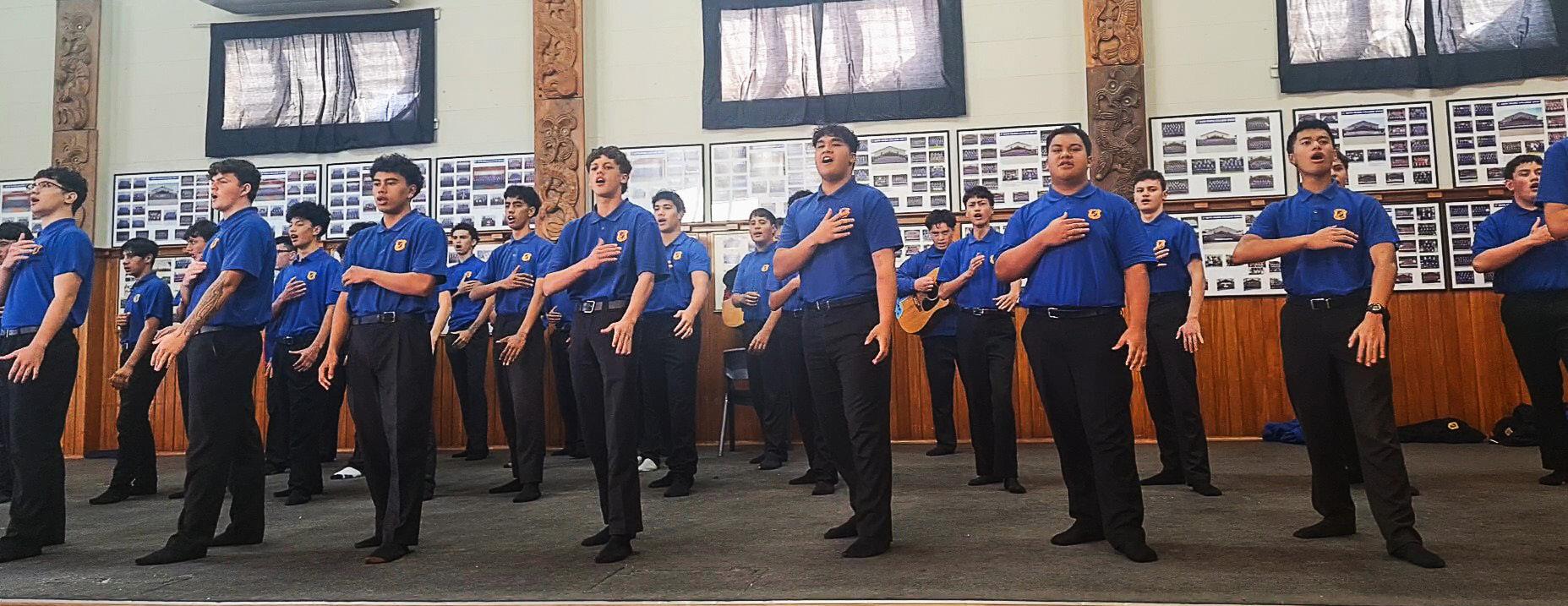
On May 25 and 26 a group of sixteen leaders in Catholic education in the Hamilton Diocese went on hīkoi to Palmerston North. The purpose of this hīkoi was
Hato Pāora is a unique taonga in our country, the only Catholic Māori boys’ college in New Zealand. The college is proud of its dual special character – both Māori and Catholic. It was a true privilege to witness and experience the way that Catholicism is expressed through a Māori lens and wairuatanga Māori is expressed through a Catholic lens.
22
Hato Pāora College tumuaki, Dr Nathan Matthews, shared his passion for matauranga Māori and Catholic education and what these look like when they come together at Hato Pāora College. An example of this was the college values and how these reflect both Māori identity and Gospel values. The significant figures depicted in the Chapel’s stunning Māori carvings included St Peter Chanel, St Joseph, Our Lady, and St Paul. Each of these figures are held as examples of the college values in action and frequently referred to by staff who break open the Gospel for the boys each morning. These deliberate actions and meaningful connections show how things Māori and things Catholic certainly can and do strengthen one another.
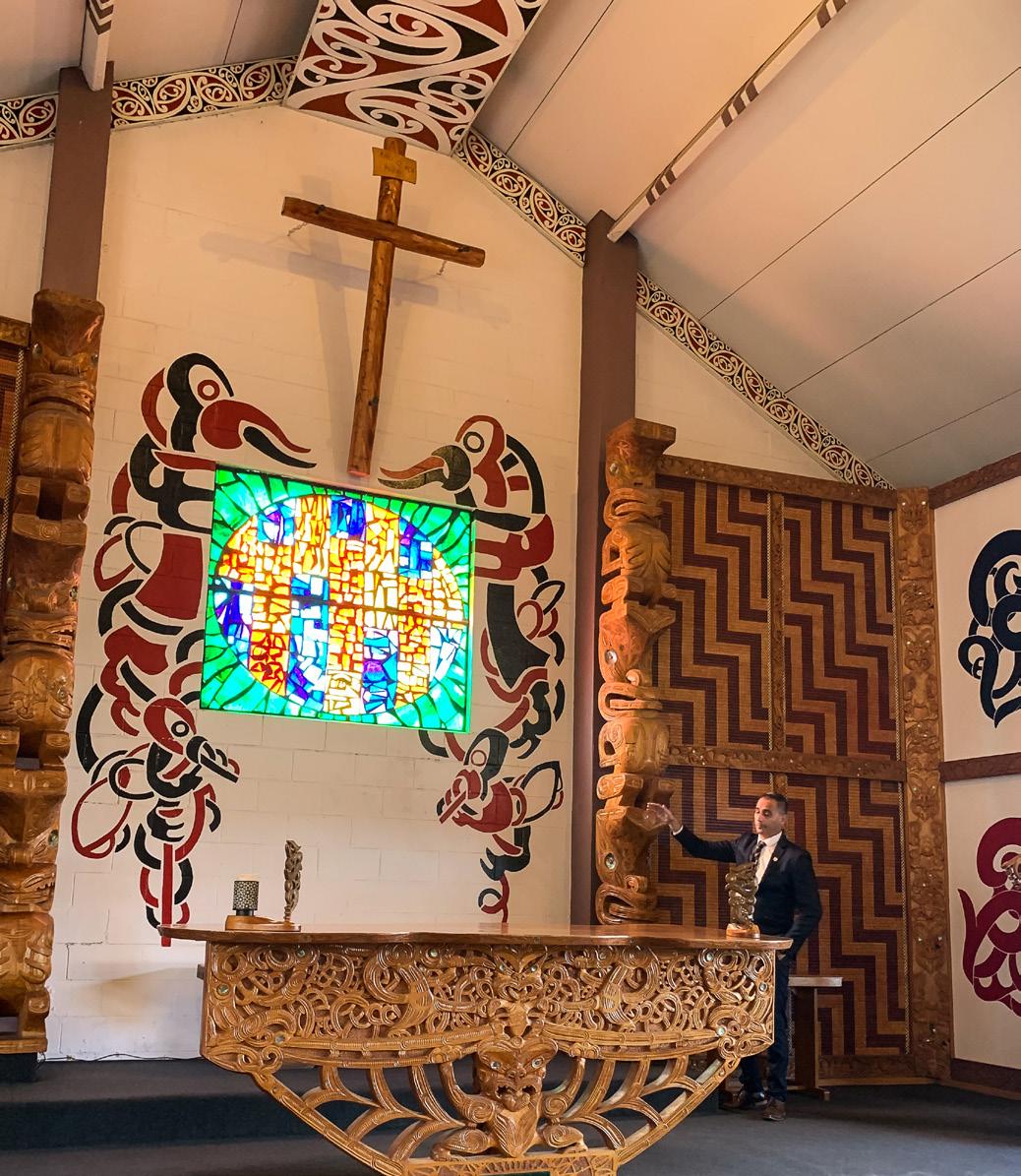
It was incredibly powerful to hear from the Year 13 young men themselves as they spoke about their understanding of being Māori and being Catholic. They spoke about living their faith proudly, in the way of Mary, as Marist men. They spoke of the opportunities provided to them to develop their faith further and their hope for the future. Following these beautiful testimonies, our roopu was treated to a kapa haka performance by the young men. The Spirit was certainly moving through this place and several of us were brought to tears through this performance, a demonstration of passion, power, and prayer through waiata, actions, and haka. This was food for the soul.
In the afternoon, we shared in the Eucharist together with the whole school. Seamlessly, the liturgy moved between English and te reo Māori and every hīmene was sung with pride and great enthusiasm. A refreshing and uplifting end to an incredibly special day at an incredibly special place.
On Friday, our roopu gathered once more for a mihi whakatau, this time at Te Rau Aroha Diocesan Centre in Palmerston North. Instead of a powerful haka pōwhiri as we had received from Hato Pāora the day before, the entire diocesan team gathered and sang Te Aroha as we moved into their place. We exchanged words and sang waiata and after a karakia was prayed in New Zealand Sign Language, we shared morning tea and prepared to continue our deep dive into how Catholicism and Māori spirituality strengthen and challenge. Jane Dravitzki (RE Advisor, Palmerston North) led the first session, talking through the significance of the carvings in their place which depicted aspects of the Māori creation story, the New Zealand missionary story, and the coming together of people through Christ. There was a sense of mutual respect between mana whenua and the diocese.
The discussion about partnership with mana whenua continued with Margaret Leamy (principal at St Peter’s College, Palmerston North) and Caroline Deazley-Gilligan (principal at Our Lady of Lourdes, Palmerston North) sharing their schools’ journeys. It was awesome to see passionate educators speaking about Catholic education within a very Aotearoa New Zealand context. They both spoke about kotahitanga (unity), whanaungatanga (connected relationships), the uniqueness of our dual cultural heritage and multicultural communities, and the celebration of our gifts, talents, and wisdom. They shared their experience working in partnership with mana whenua, the challenges and the positive outcomes they have seen for all students because of the work they continue to do in this space. An exciting journey continues for these schools!
Our roopu finished up the hīkoi time together with discussion about what we had experienced and how we could bring some of these learnings back to the context of our own diocese and our own schools.
A truly spiritually and culturally nourishing experience and, as a Catholic Māori wahine, one I will hold close to my heart. Ngā mihi.
23
PHOTOS SUPPLIED: KAPA HAKA AT HATO PĀORA (LEFT), KŌRERO ABOUT THE TAONGA IN THE CHAPEL’S SANCTUARY (ABOVE).
FROM FONT TO BIRDBATH AND BACK AGAIN
BY FATHER GERARD BOYCE
The baptism font that stands in St Pius X Church, Melville, Hamilton, is a unique and storied piece of liturgical furniture. It is original to St Pius X Church and was installed when the church was opened in 1956.

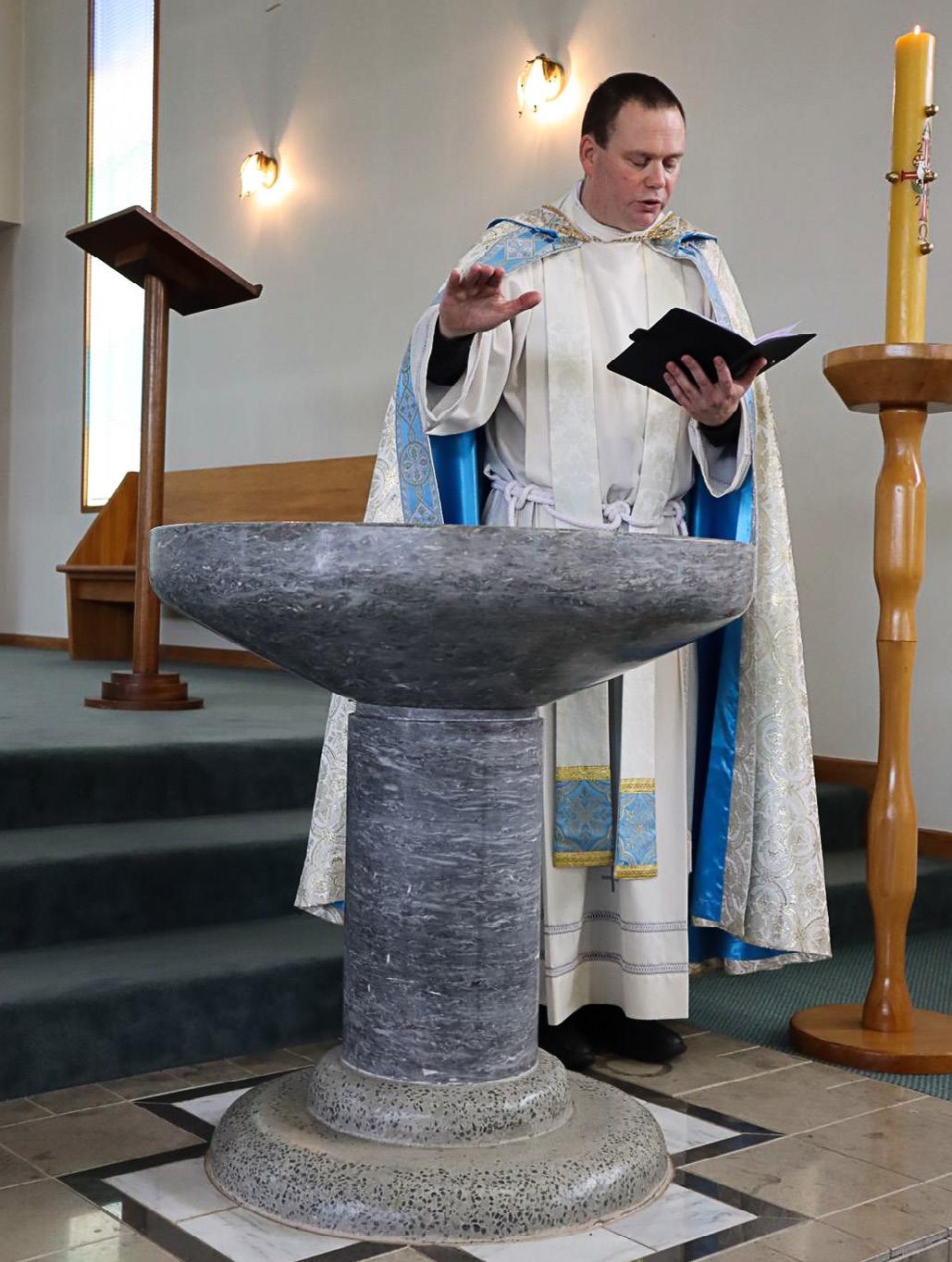
The font was donated in early 1956 by a parishioner, Mrs Eileen McNamara, who paid 750 pounds for it. It is made of Takaka marble, sourced at the top of the South Island, and was fashioned in Christchurch. When the font was installed in the church’s foyer area at the rear of the building it had a copper lid which has since disappeared without trace, and was within a baptistry, marked by iron gates, which are also since lost.
Around 1992 the foyer of the Melville church was remodeled and the baptistry was removed. The font was also removed and was stored in the presbytery garden.
While it is within the Melville church now, it hasn’t always been there, and what follows is a short (and pretty reliable) narrative of its travels.
24
PHOTOS BY SAM COLLIE: ST PIUS X PARISH PRIEST FATHER DANNY FRASER-JONES WITH THE RESTORED FONT (LEFT) GIUSEPPE, SON OF BRIDGET AND JOHN DE VEGA, IS BAPTISED IN THE RESTORED FONT (RIGHT).
After some time there, the font was given to St Peter Chanel Parish, Whakatane, when that church was itself remodeled in 1996. It was, for many years, in the main aisle of that church.
I attended Fr Matt McAuslin’s ordination in Whakatane in 2008, and I noticed that the font had been removed and was in the courtyard outside the church. About this time, as far as I can make out, Mr Matt Boonen, a parishioner from Whakatane, purchased it from the parish, and he placed it in his extensive garden on his Awakeri property.
In my first days at Melville in early 2011, I was told about the font and its location, and was urged to make its return a priority. A query letter to the Whakatane parish council on the subject proved unproductive, and it wasn’t until the latter half of 2012 that there was any real progress.
At a clergy gathering in 2012 I learned from Fr Robert Sharplin, then P.P. at Whakatane, that Matt and July Boonen were to sell their property in Awakeri and move to Whakatane. Given this development I wrote to Mr Boonen about the possibility of returning the font. I spoke of the history of the font at Melville, and also reminded him that he had been my first soccer coach back in 1977! Mrs Boonen rang me, and said she and her husband would be delighted to see the font returned to Melville. After a reconnaissance visit in early December 2012, I returned with some others nearer Christmas and we spent an afternoon digging it out
of the Boonens’ garden.
The other font-retrievers were Jamie Cox and Alex Bailey, while Gabrielle Fromont attended as event photographer. The font, in clear need of restoration, was returned to Melville. This renewal was expertly undertaken by artist Michael Pervan at the Studio of St John the Baptist in Auckland throughout 2013. He and some others from the studio installed the font at St Pius X in early 2014. It was blessed after a Sunday Mass in early March.
Brian McNamara, the son of Eileen McNamara who donated the font, himself a Melville parishioner, was present at the blessing, and poured the first water into the renewed font. Other members of the wider McNamara family were also there.
The first baptism in the restored font took place on March 2 2014, when Seraphine Roberts, daughter of Peter and Rosemary, was baptised into the death and resurrection of Christ.
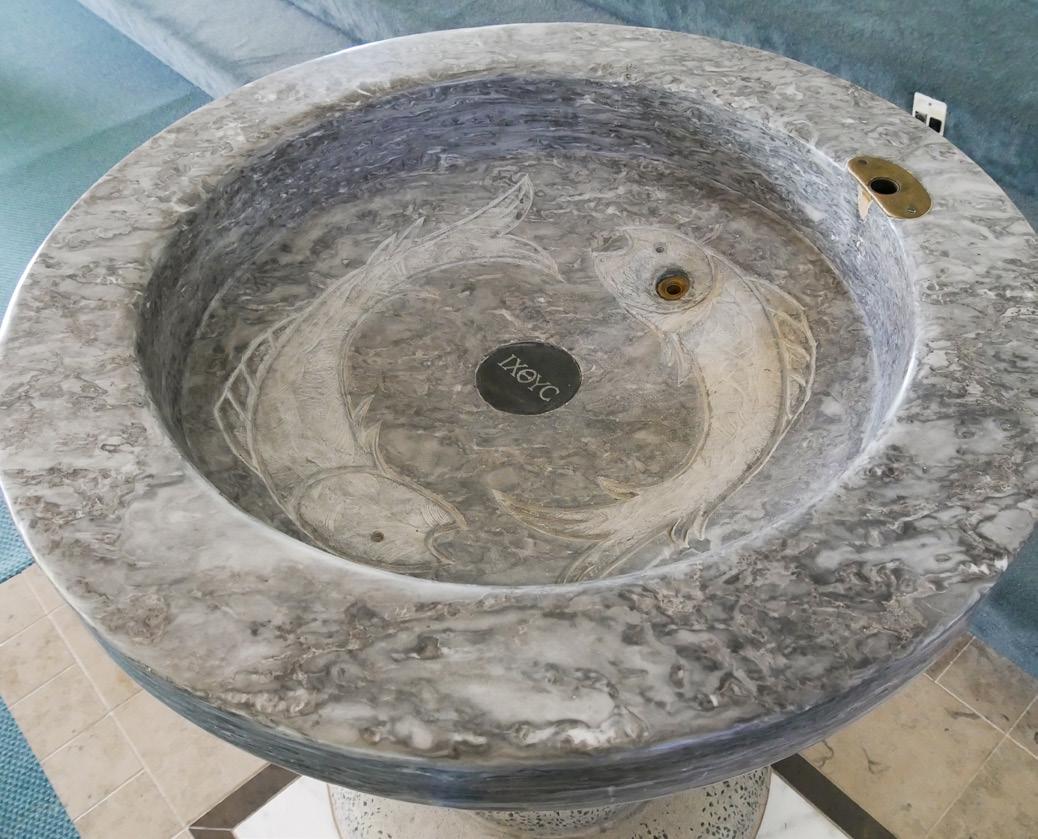
The font today, I am told, sees frequent use for both Latin Rite and Syro-Malabar Rite baptisms. In my time serving at Melville, the font was also regularly used for baptisms according to the pre-Conciliar Ordo Baptismi Parvuli. It has also been used for the baptisms of the children of John and Bridget De Vega; Bridget is the great-grand-daughter of Mrs McNamara, the original benefactor from 1956.
(Mr Mathias Boonen died in January 2023, and was buried from St Peter Chanel Church, Whakatane. Requiescat in pace.)

25
INTERIOR OF THE FONT AS IT NOW STANDS (TOP) PRE RESTORATION PHOTO BY GABRIELLE FROMONT (RIGHT)
LETTER TO THE EDITOR
VOTING FOR THE UNBORN AND THE VULNERABLE
We have a duty to vote into Parliament only those politicians who are committed to protect the lives of every person in the community from conception to natural death.
Those candidates for election to government who are not prepared to protect the lives of the unborn or the vulnerable in our community have forfeited their right to sit in our parliament and do not deserve our electoral support.
There are many issues facing our community at the upcoming general election on October 14 - cost of living, law and order, health, and education - however the most important issue is the protection of our God-given right to life.
As Catholics we have a duty to elect a government that is committed to upholding the sanctity of life in a culture of life that is opposed to a culture of death.
There were 13257 innocent and defenceless precious infants of God who were killed in abortion in 2021. There were 257 patients who, under the provisions of the End of Life Choice Act, were euthanised by their doctor or assisted to suicide in the year 2021 - 2022.
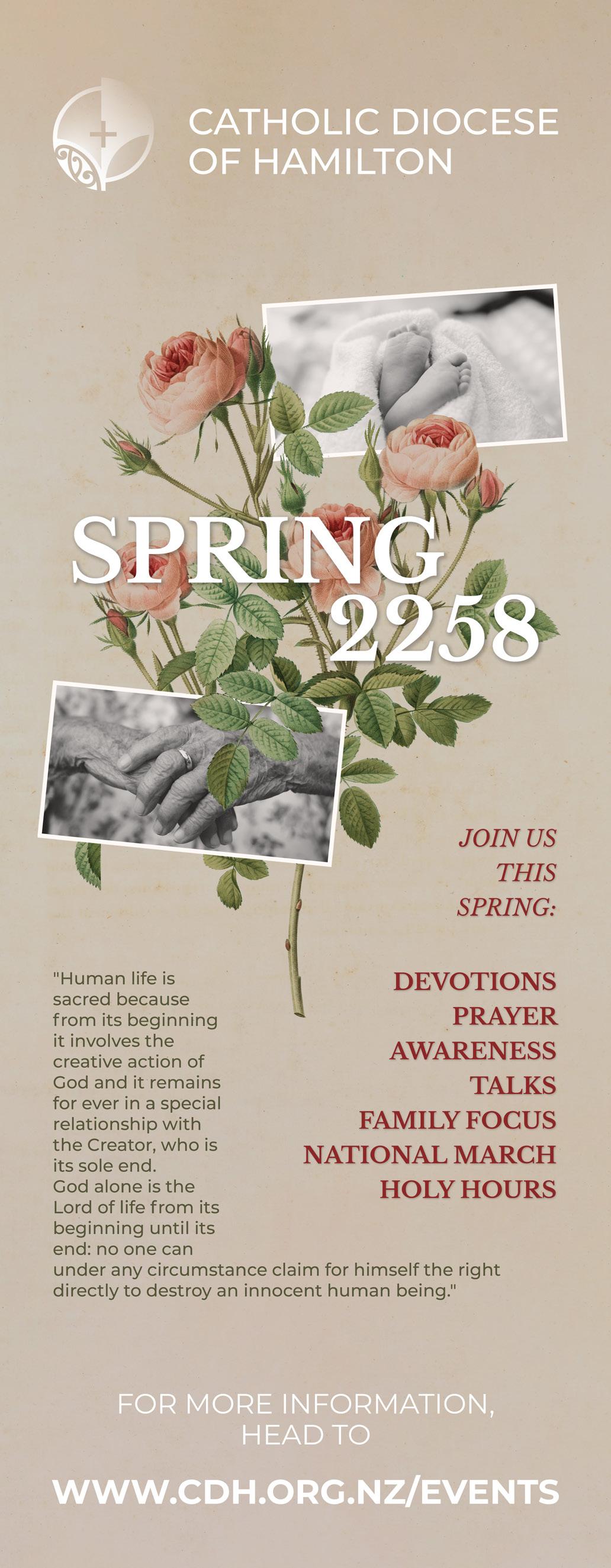
Right to Life encourages voters to defend life by voting only for candidates and political parties who are committed to defend life.
Ken Orr, Secretary, Right to Life New Zealand Inc. (abridged)
Kete Kōrero refers readers to the New Zealand bishops’ statements (and the statements of other bishops’ conferences) on voting in national elections.
26
REVIEWS
THE SHOCK OF SPRING - BOOK REVIEW BY RICHARD TURNBULL
AFTER SO MANY FIRES BY JEREMIAH WEBSTER WISEBLOOD BOOKS, 2018 SECOND EDITION
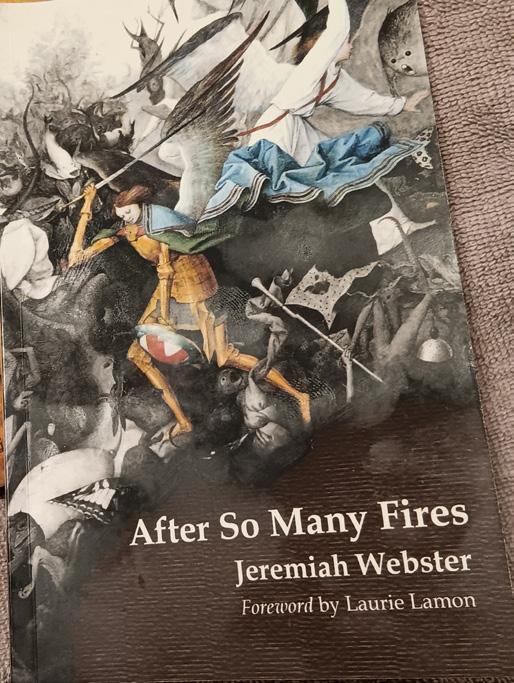
Jeremiah Webster is an American poet and professor of literature at Northwest University in Washington state. His collection of poems After So Many Fires first appeared in 2015. Interviewed about this book he made the point that the sickness of modernity was a product of its rejection of
an eternal perspective. The religious outlook on life has been replaced by the false idol of materialism, and the pursuit of wisdom, which is the knowledge of the good and the true, has been replaced by the busy accumulation of data and the enlargement of practical knowledge.
This idea is expressed in the
first poem, ‘Credo,’ where the phrase “world falls apart” is repeated in every stanza and is worked out in subsequent poems. In a world where sins have been replaced by mistakes he can call out, “Lord, forgive us our sins / as we have forgotten them” (‘All Saints’).
This is the poet’s difficult job, to disquiet and discomfort and remind; for, as he says in ‘Life Work’: “In the life after death, poets / are the only ones in the same / line of work.”
Webster talks not only of the here and the now but of the eternal and the transcendent; not only of a world falling apart but of one - in ‘Credo’ once again - where it is worthwhile to build “my home,” study “my books,” sell “my possessions,” and “sing second life.”
Webster leaves no doubt of the emptiness and horrors of the modern world, of a world where people no longer read books - ‘Literacy’; fanatics commit atrocities - ‘New
Normal’; advice to abort a baby comes from within a girl’s own family -’Reprieve’; all is permitted because there is neither right nor wrong nor truth - ‘Post-Truth’; land and sea are polluted - ‘Ecclesiastes’; and humanity is desacralised and reduced to the merely animal - ‘For Our Own Good.’ The vision presented in ‘For Our Own Good’ is a terrifying one: “they are preparing death / for us, death and no room / for a wife to hold her husband.”
This is a world of science as end in itself, severed from all moral considerations. The universal bioethical maxim primum non nocere, first do no harm, is become a sterile maxim: What grace to have been born before respirators and die the last breath your own. - ‘Machines Were Keeping Her Alive’
In such a world only the naïve believe the claim that databanks and A.I. (artificial intelligence) are neutral: “as algorithms assign guilt / and avatars eavesdrop?” (‘For our own good’.)
And yet, in a deeply moving poem about his father, a Christian minister, we learn of the readiness of words to shake us from sleep, to move us like a winged Christ across the soul and burn until the work is done - ‘Ember’
In perhaps the most beautiful poem in the book, ‘Fear Spring,’ Webster shows us that this fallen world carries with it a power of enchantment. What startles and redeems is the authority of grace. A six-month bitter winter of hibernation and “snow the colour of car exhaust” yields suddenly to the shock of spring, and men, stirring forth, stumble into the alliterative pulse and exquisite susurration of “… sun blind and restless in remorseless wind.” The poem ends “the ambient chant forever forever / that sent us indoors like a storm. The trailing syllables of “forever forever,” and their gentle rise and fall, express, like a liturgical chant, the miracle of spring which fills space forever: a fallen world redeemed by an eternal perspective.
27
IF I AM ONLY FOR MYSELF - THEATRE REVIEW
 BY SAMUEL HARRIS
BY SAMUEL HARRIS
THINGS THAT MATTER BY GARY HENDERSON DIRECTED BY ANAPELA
POLATA’IVAO AUCKLAND THEATRE COMPANY
David Galler, an Auckland doctor, says of his profession: “Acts of love: that is what health care is … It’s those really intimate moments we have with people … That connection, that intimacy, and that responsibility: these are awesome things and that needs to be recognised.”
Auckland Theatre Company wanted to be part of this recognition and commissioned playwright Gary
Henderson to turn Galler’s 2016 memoir Things That Matter into a play, and after being delayed during the pandemic, the play had its debut in Auckland in August. It tells the story of Dr Rafal Beckman, the son - like Galler - of Polish Jewish refugees, who is an intensive care specialist at Auckland’s Middlemore Hospital, along with the stories of three of his patients and their families in the busy-ness of the hospital’s ED and ICU; these stories are intertwined with the story of Raf’s mother, Roza, a Holocaust survivor, who is dying of cancer. Henderson in his writing and director Anapela Polata’ivao in her orchestration of cast and crew succeed in bringing together some pretty big ideas - the Holocaust, religion, suffering, dignity, end of life care, race and racism, health, the game of politics. These are complex, wordy, nuanced ideas,and they’re expressed through finely-observed human experiences in a piece of theatre which certainly has some challenges and observations it wants to express but which avoids cheap soap-boxing. The play is beautifully presented at ATC’s impressive home theatre on the waterfront. The crystal clear sound design features music edgy and poignant by turns; the costuming is in fittingly subdued beiges, greens, and pastels; the set changes from the bright sterile plastic and steel of the hospital, to a warm family home, to the banal plainness of a government office with clever use of lighting, screens, and props; and transitions from scene to soliloquy to new
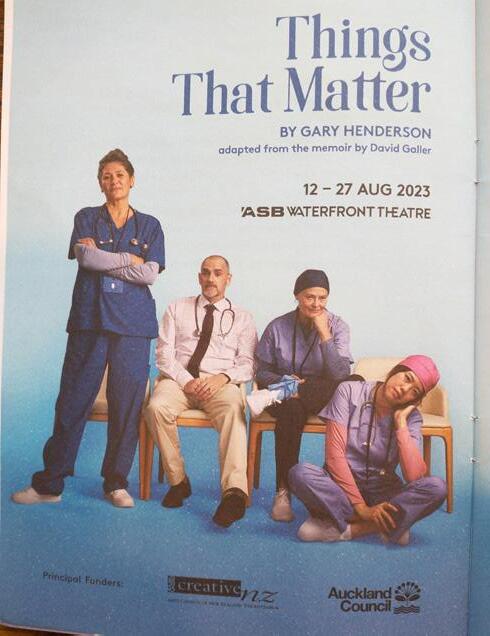
scene are achieved with lighting, music, and projected visuals.
Some highlights for me:
The play makes a link that some viewers might regard as a bit on-the-nose but which succeeds given the skill of the artists: a link between the horrors of the Nazi regime in the dehumanisation of those people (primarily the Jewish people) to whom it applied its sickening machinery of death and suffering and the kind of dehumanising that occurs in twenty-first century New Zealand where people are reduced to labels, seen merely as categories, or deliberately or unthinkingly marginalised due to embedded flawed - or, let’s be blunt, sinful - attitudes, rather than being seen and treated as human persons deserving of dignity and respect.
“At least get her name right,” Ana, a nurse, says to Edie, a doctor, who is clearly making no effort to pronounce a Samoan patient’s name correctly. “If you get the name right, you see the person.”
The idea becomes powerful, and quite moving, as Roza relates the experience of her family in the deathcamps watching Dr Josef Mengele - the infamous “Angel of Death” - flicking his cane casually at prisoners getting off a train: “Waving his wand - left to work, right to die. One glance he made - how can you know a person with one glance? … To them we weren’t people.”
Raf and his father Leon pause at one point, look at the audience, and say together, “Suffering.” People suffer in this play - patients are sick and broken, some of them beyond repair; exhausted healthcare workers are
28
overworked to breaking point as they do their best against a host of difficulties, some of them apparently caused by their managers; Roza suffers nightmares and the pain of terminal cancer. Early in the play she bluntly expresses her personal experience of the age-old cry, “Where is God in the midst of terrible suffering?” and talks of no longer believing, no longer practising her faith. She doesn’t want a synagogue funeral and she wants cremation - “I want my body burnt like my mother’s was [at Auschwitz]” - rather than the traditional Jewish rites for the deceased. She dies in the play’s final scenes, and Raf and his father - who has been a ghostly voice of conscience throughout the play - recite the traditional Jewish prayer for the dead, the Mourner’s Kaddish. Leon leads initially as Raf fumbles for the Aramaic words, then falls silent as his son finds his voice: in English, the prayer reads: “Glorified and sanctified be God’s great name throughout the world … blessed be he, beyond all the blessings and hymns, praises and consolations that are ever spoken in the world; and say, Amen.” Raf seeks solace in faith, and in offering his mother something he feels she might yet still value, he expresses the hope of God’s understanding and mercy of his children’s suffering and doubt.
In the play’s final moments its ideas come together as Raf steps forward to the edge of the stage and addresses the audience, returning to a well-known quote from Jewish elder Rabbi Hillel which he and Leon had discussed earlier: “If I am not for myself, who will be for me? But if I am only for myself, what am I?” He pauses then completes the quote, delivering a challenge, “And if not now, when?” He moves back to centre stage, where the rest of the cast have gathered around the body of his mother Roza, finally at rest, and together they sing - quietly, mournfully, but with hope - a modern folk song by the band Sheva, Salam: “Od yavo shalom aleinu / Peace will come upon us, yet.” Not at all a glib, “Chill out, everything’s gonna be OK in the end” but a challenge: What am I, a professing Catholic, doing to bring about peace, to help address the inequities of life in Aotearoa New Zealand in 2023 and to assist in easing the suffering of my neighbour: if not now, then when? And if not you, then who?
ATC’s next production is “Switzerland” in September and October, and “Divas,” featuring singer Bernadette Robinson, runs in October at Waterfront Theatre.

29
RIGHT WHERE WE SHOULD BE - MUSIC REVIEW
BY SAMUEL HARRIS
BRIGHT NOVEMBER MORNING
BY DON MCGLASHAN
Don McGlashan - recently inducted into the New Zealand Music Hall of Fame - has long been one of our best and most thoughtful singer-songwriters, and he’s currently finishing up a national tour playing songs from his back catalogue and latest album, Bright November Morning. Pope St John Paul II wrote in his 1999 Letter to Artists that “society needs artists … to probe the true nature of man, his problems and experiences, as he strives to know and perfect himself and the world.” This probing and questioning is all through McGlashan’s art. Much of it is grounded in stories of the ordinariness of life but McGlashan is always wanting to dig down into that ordinariness, to see what’s going on, and to then highlight the beauty and grace - or the mystery and strangeness - of the human experience.

‘Now’s the Place’ begins with ambiguity - “So this is now? Well that depends” - then after an exploration of past versus present it settles on a declaration of the importance of the present moment: “But here we are / Right where we should be / Now’s the place / For you and me.” A toddler plays on a beach in ‘Sunscreen’: “You took your first steps in the sand / A tiny Michelin Man” then the song shifts to a wider view: “You let go my hand / Stagger away / Toward the whole wide world” - this is something of the “problems and experience” of parenthood, isn’t it: the joy of watching your kids grow and learn in your protective embrace alongside the difficulty of eventually sending them out to stand on their own two feet.
‘John Bryce’ is a song of anger, telling the story of the “bright November morning” in 1881 when Native Minister John Bryce brutally and cynically led a force against local Māori at Parihaka who were peacefully asserting their right to dwell on their own land.
‘Shackleton’ and “All the Goodbyes …’ are moody, even spooky, displaying the way McGlashan uses small details to sketch pictures of extremes of human experience on which the listener can hang their own story. Fleshing out
the lyrical sketches is McGlashan’s band - one of the best he’s worked with I think - featuring Shayne P. Carter’s guitar and Chris O’Connor’s percussion.
The album closes with ‘Start Again,’ a song about love and hope: “When there’s too much space in this town / And not enough grace to go around / … Lay your head on my chest / Close your eyes, get some rest / In the morning we’ll start again / We’ll start again.” Highly recommended.
SAINTS & SOLEMNITIES
SEPTEMBER
23 - St Pius of Pietrelcina
24 - Our Lady of Mercy
27 - St Vincent de Paul
28 - St Lawrence Ruiz and Companions
29 - Sts Michael, Gabriel, and Raphael
OCTOBER
1 - St Teresa of the Child Jesus
2 - National Day of Celebration for Ven. Suzanne Aubert
7 - Our Lady of the Rosary
9 - National Day of Prayer to Support Life
11 - St John XXIII
14 - St Hedwig
19 - Sts John de Brebeuf and Isaac Jogues and Companions
22 - St John Paul II
NOVEMBER
1 - All Saints Day
2 - All Souls Day
3 - St Martin de Porres
10 - St Leo the Great
19 - World Day of the Poor
24 - St Andrew Dung-Lac and Companions
26 - Our Lord Jesus Christ, King of the Universe
30
KIDS
ACROSS
4. Patron saint of cooking.
6. Regarded as the author of the first five books of the Old Testament.
8. Traditionally, Joseph’s trade.
9. In the Genesis account, on which day did God create humans?
10. Language in which the majority of the Old Testament is written.
DOWN
1. Regarded as the first apostle called by Jesus.
2. The river where Jesus was baptised.
3. Who was given a coat of many colours?
5. The source and summit of the Catholic faith.

7. In Mark’s Gospel, what Simon Peter was doing when he first met Jesus.
11. Event where Jesus’ first miracle was performed.
31
1 2 3 4 5 6 7 8 9 10 11
ACROSS
4. LAWRENCE
6. MOSES 8. CARPENTER 9. SIXTH 10. HEBREW DOWN 1. ANDREW 2. JORDAN 3. JOSEPH 5. EUCHARIST 7. FISHING 11. WEDDING
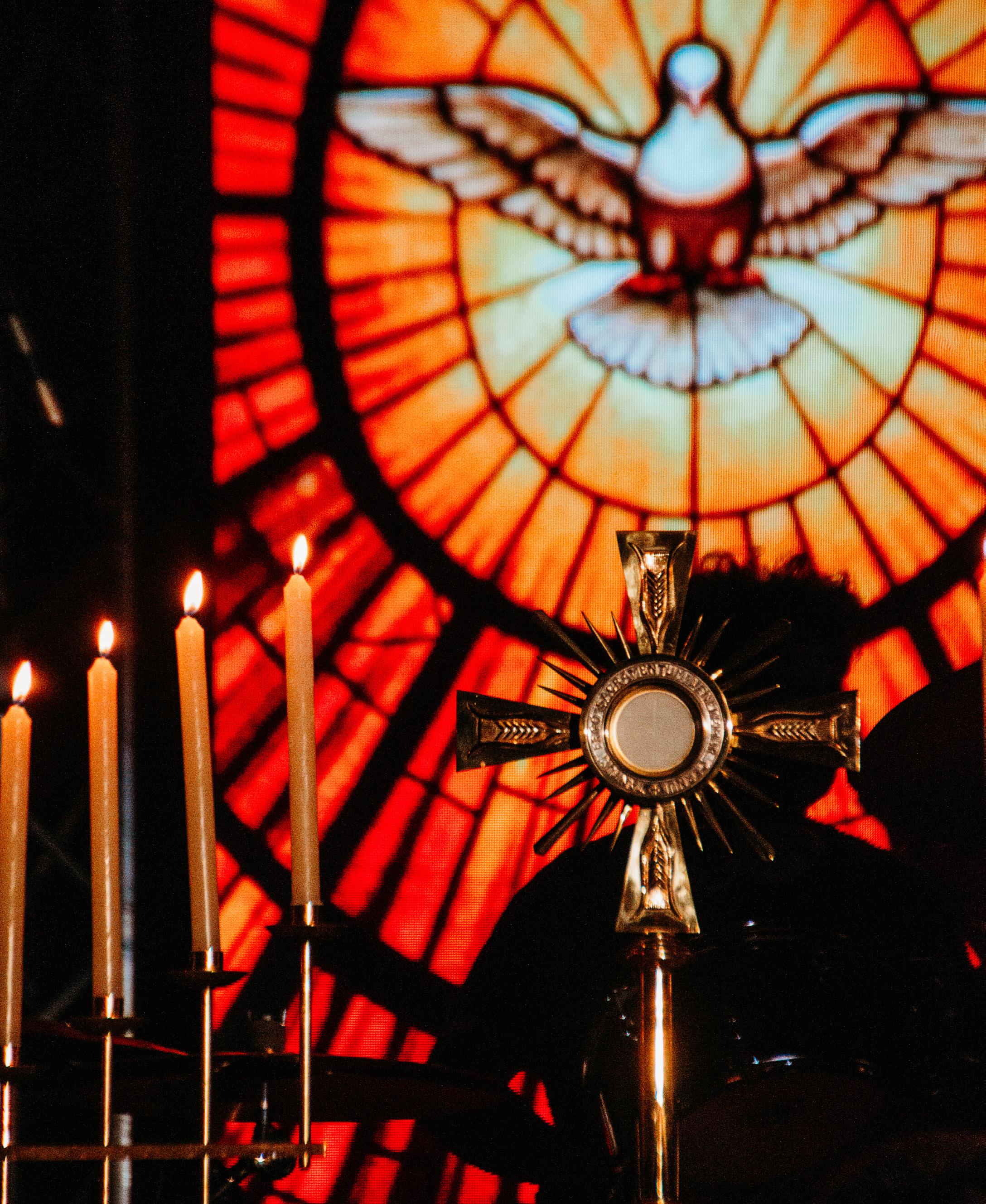
CDH.ORG.NZ
































 BY TAILA BURTON-GOLLOP
BY TAILA BURTON-GOLLOP








 BY SAMUEL HARRIS
BY SAMUEL HARRIS




